1. The document discusses object oriented programming concepts like classes, objects, inheritance, and polymorphism in C++.
2. It begins with an introduction to procedural programming and its limitations. Object oriented programming aims to overcome these limitations by emphasizing data over procedures and allowing for inheritance, polymorphism, and encapsulation.
3. The document then covers key OOP concepts like classes, objects, constructors, and static class members in C++. It provides examples of creating classes and objects.
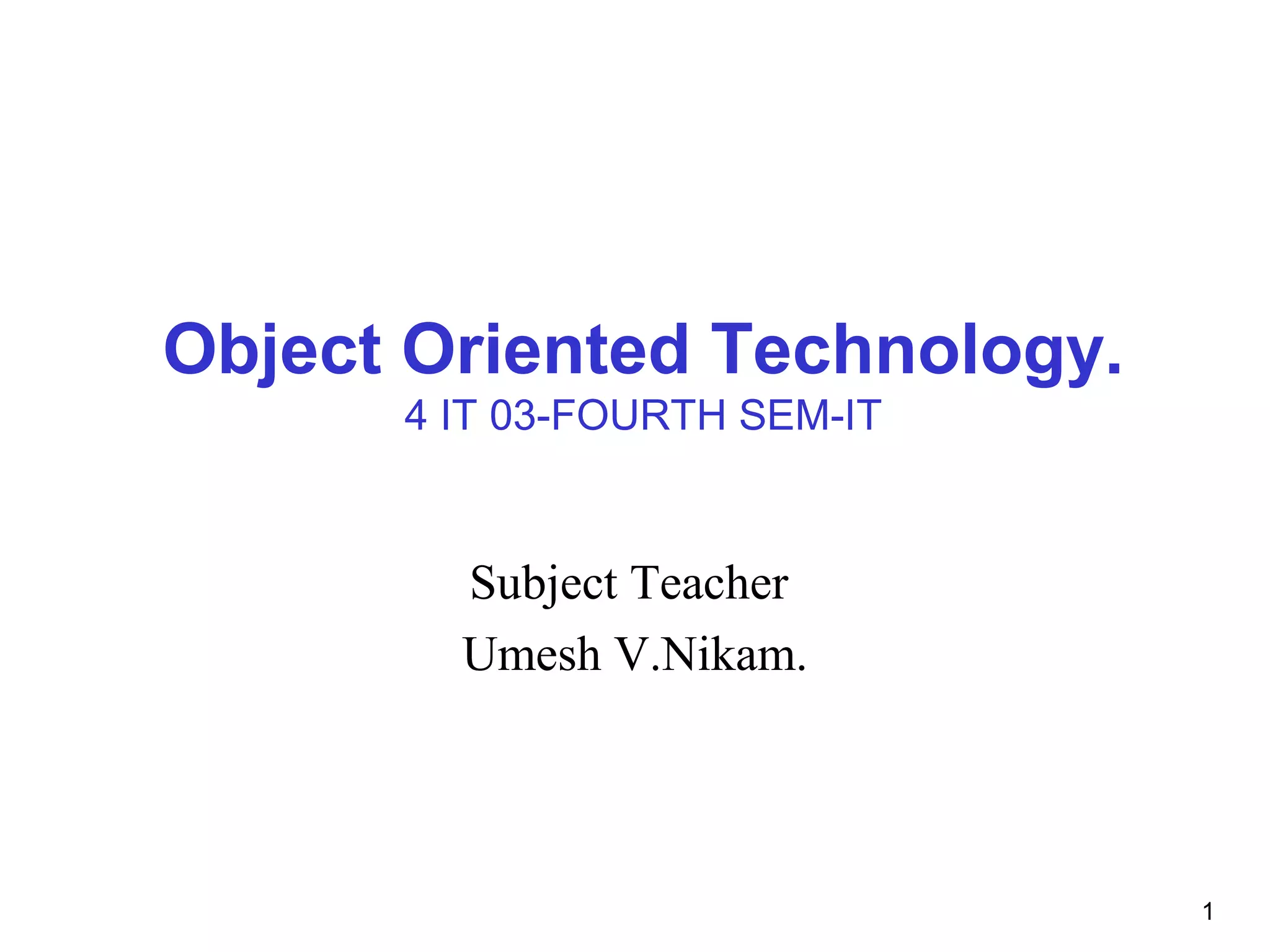

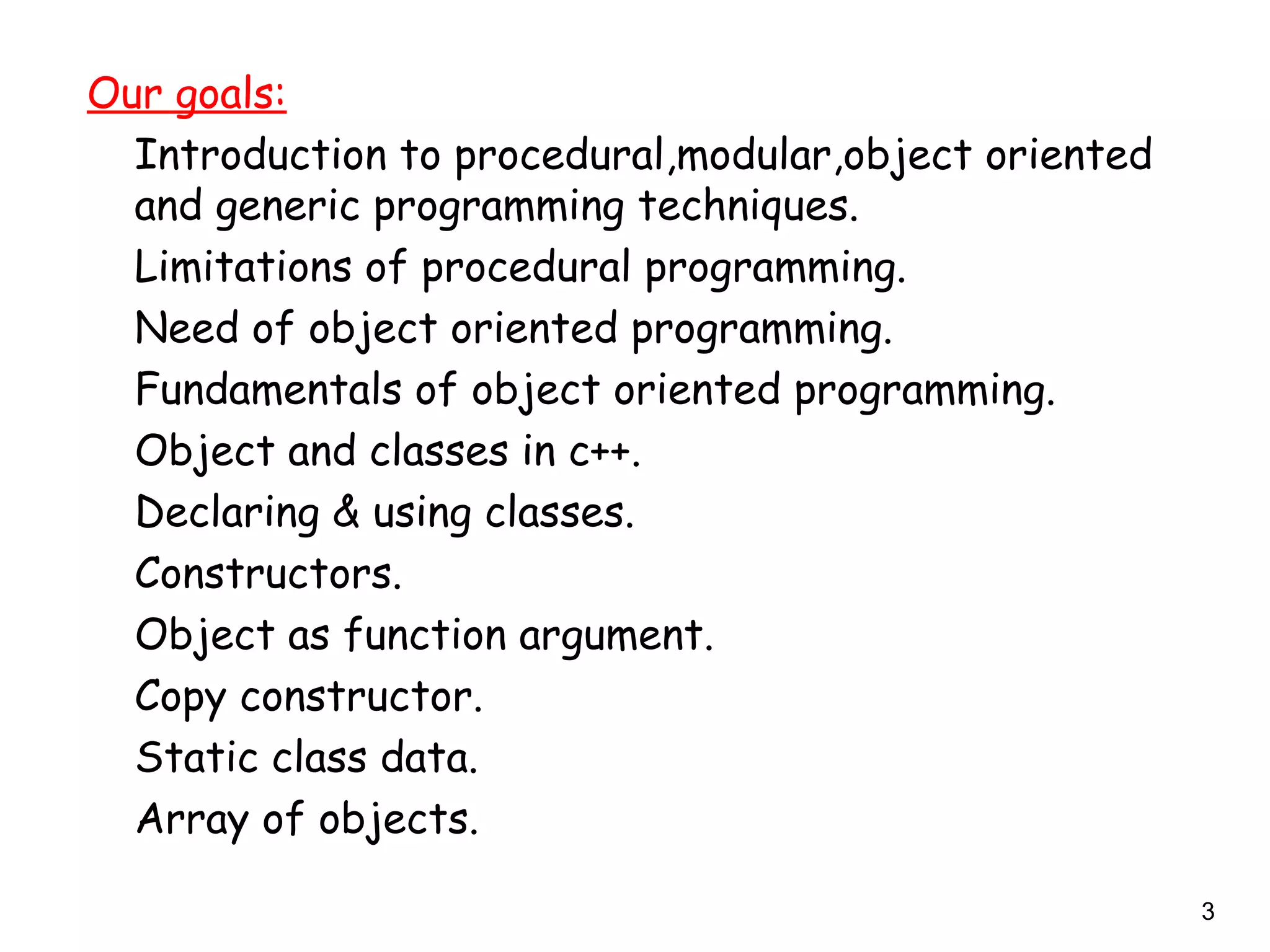
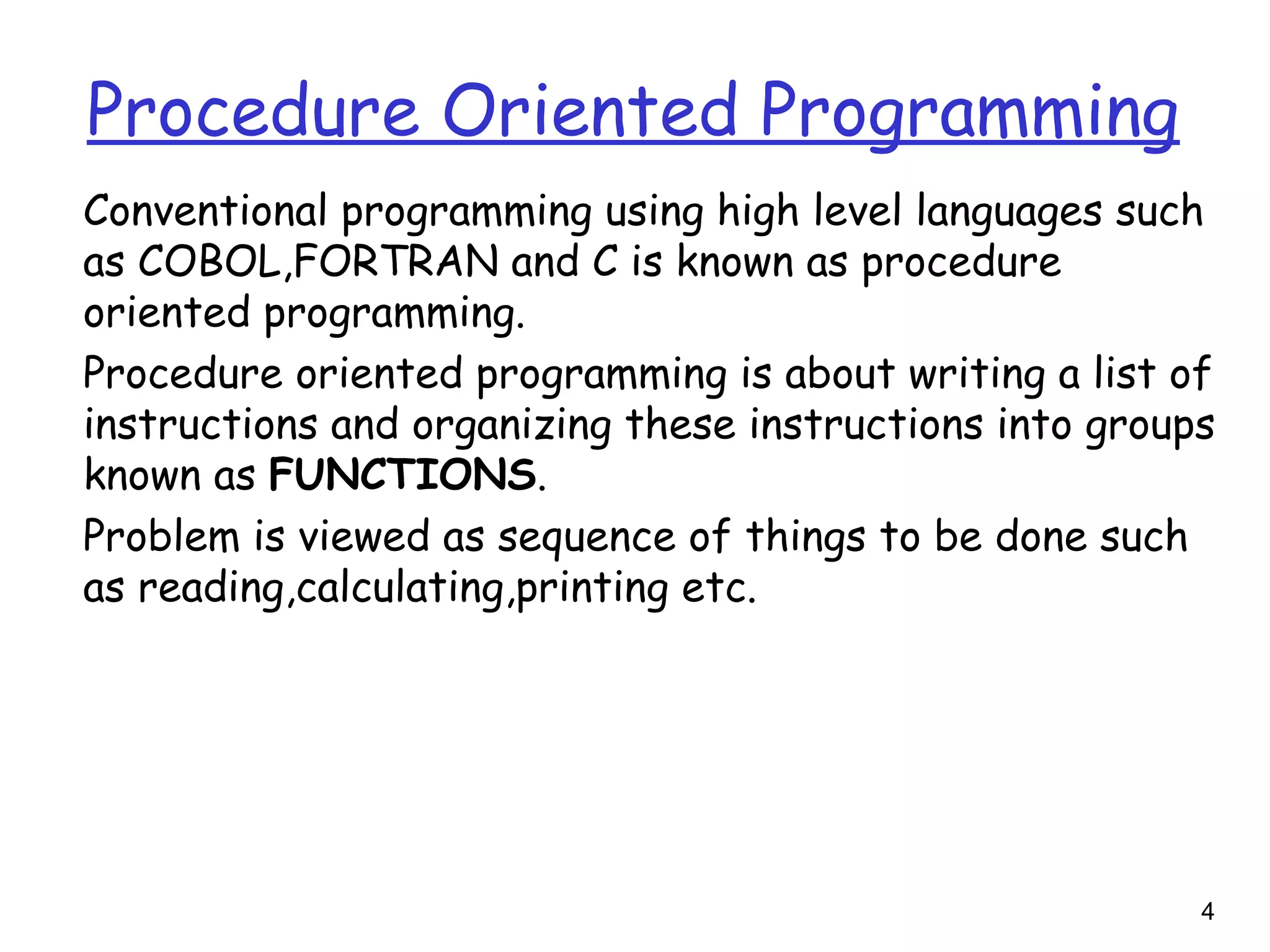


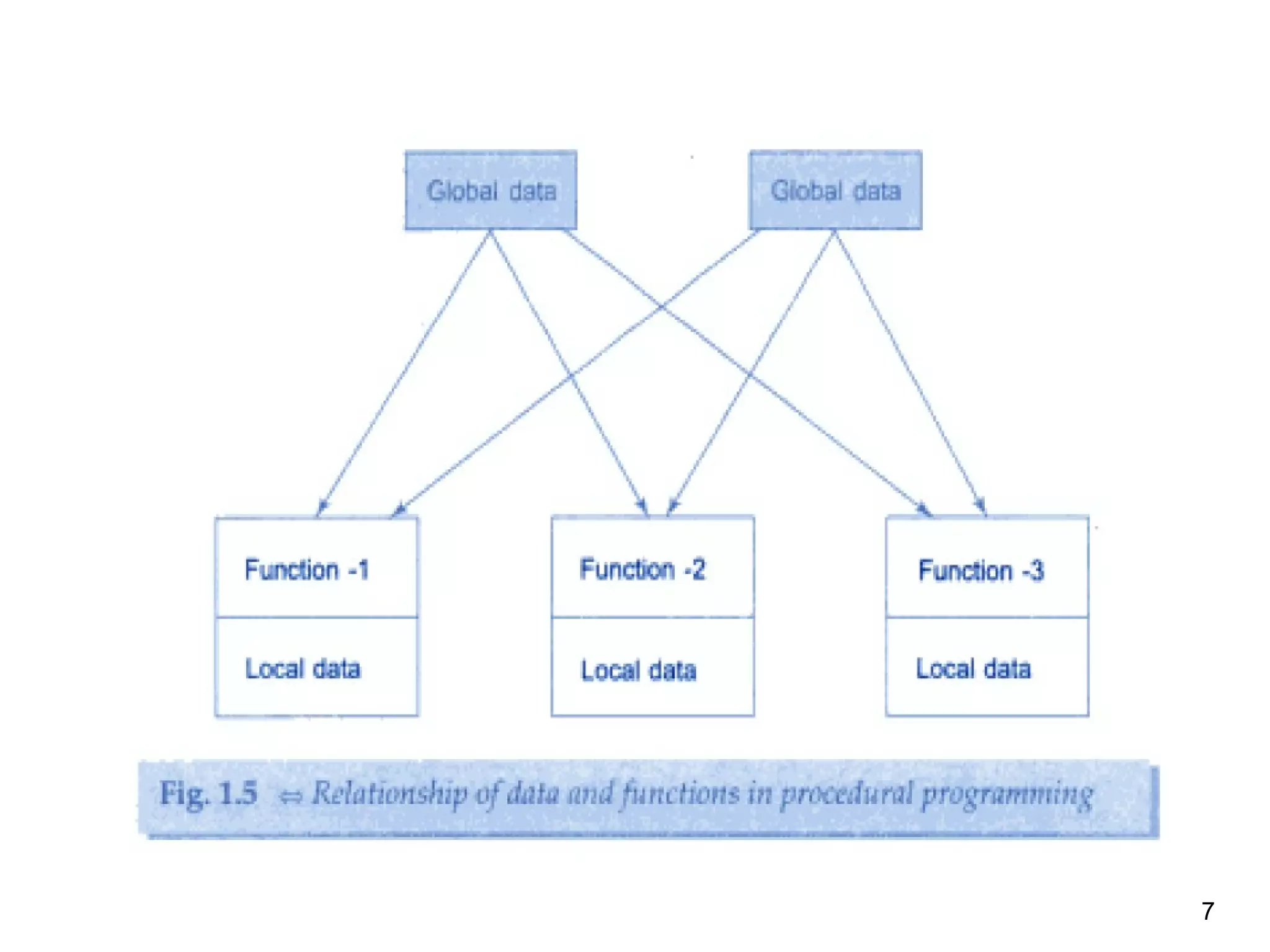

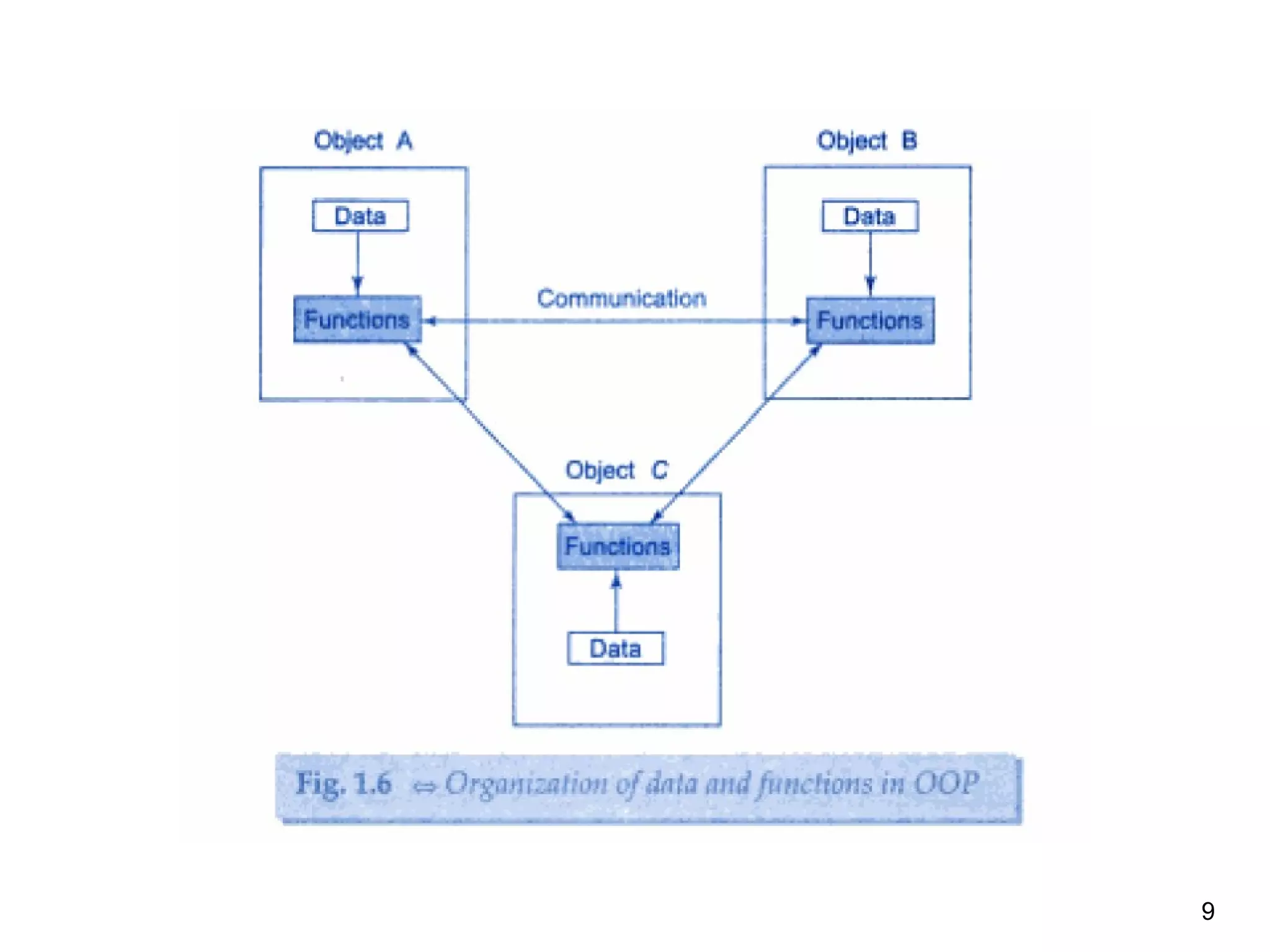
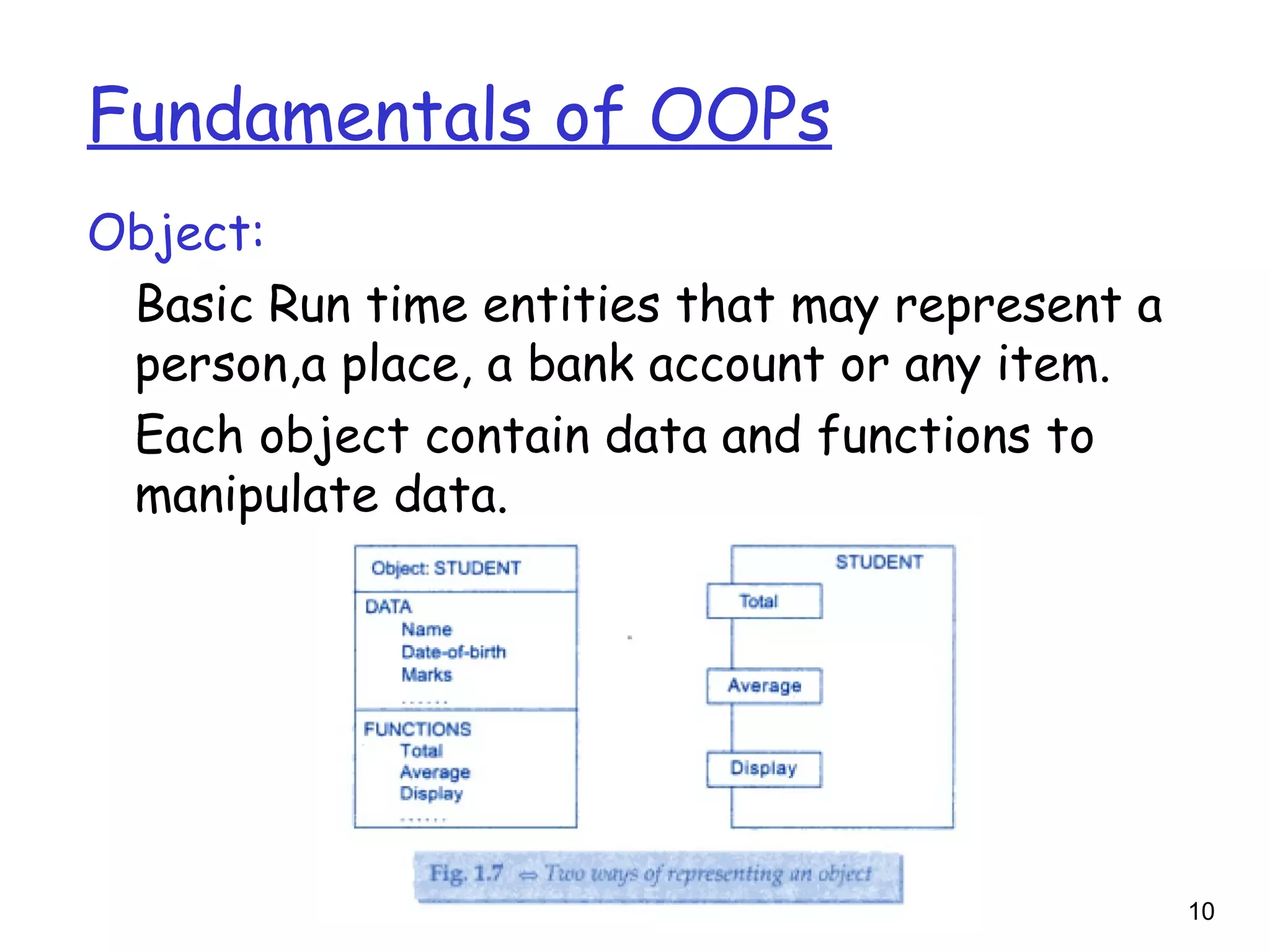
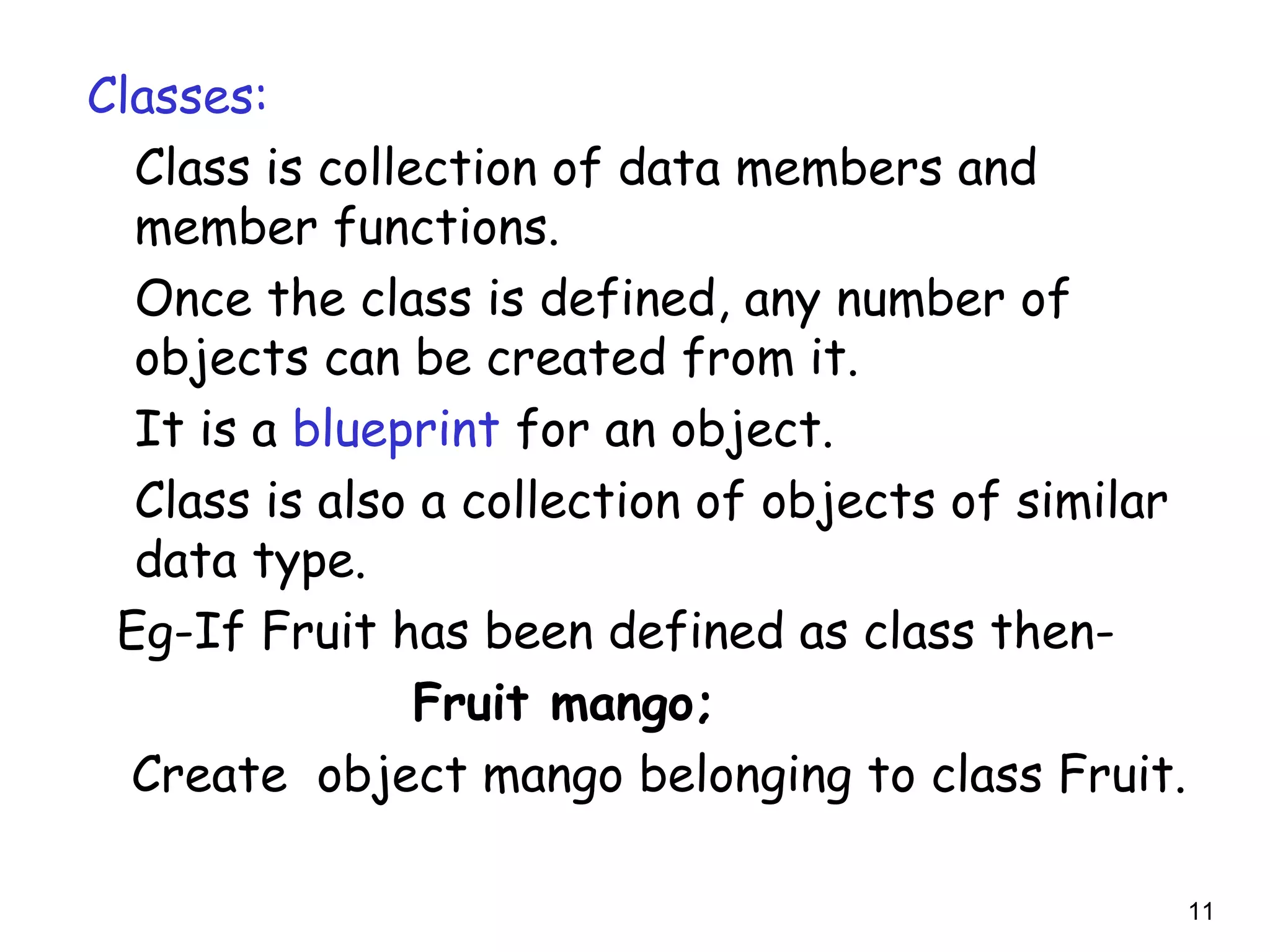



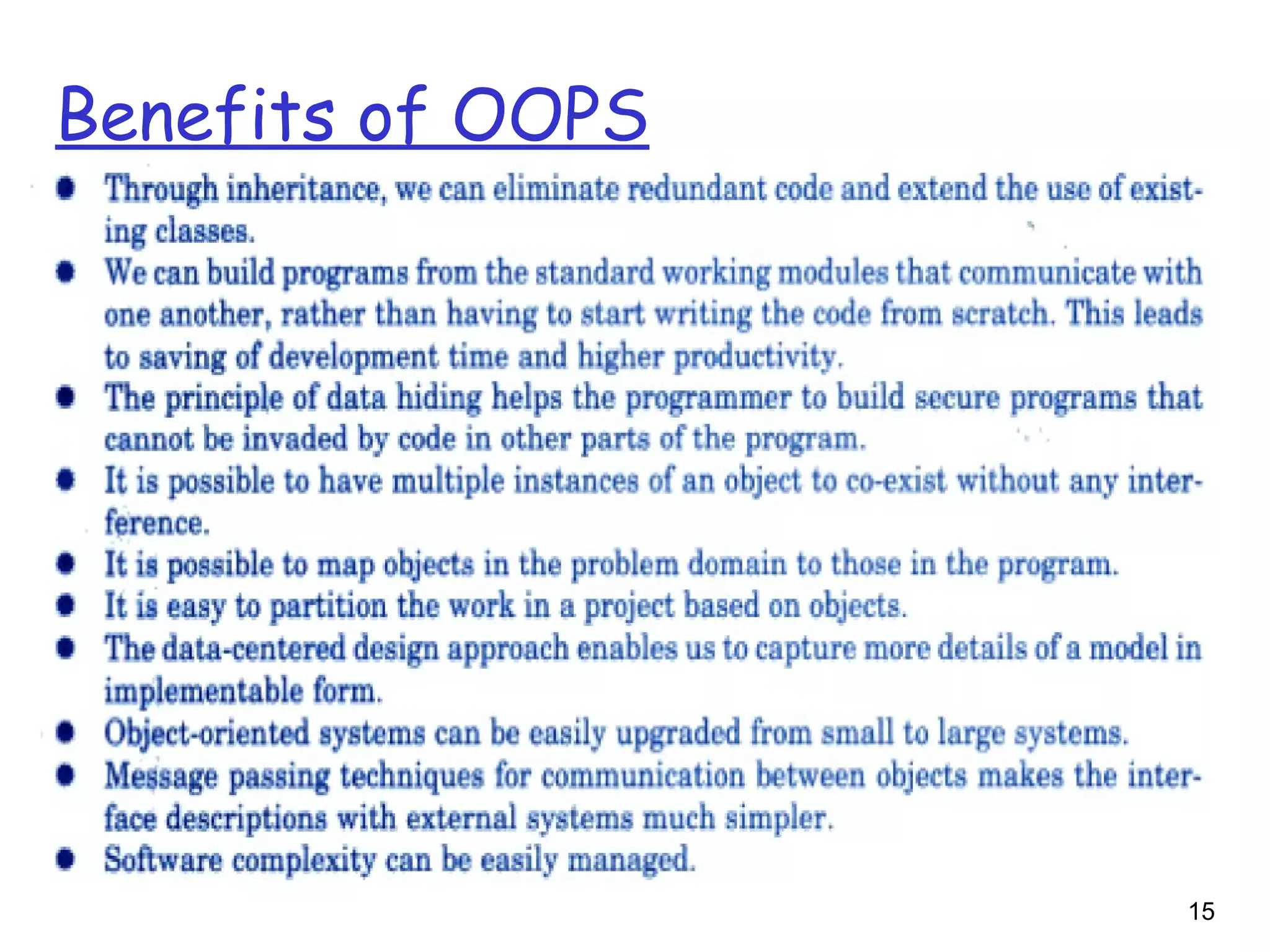


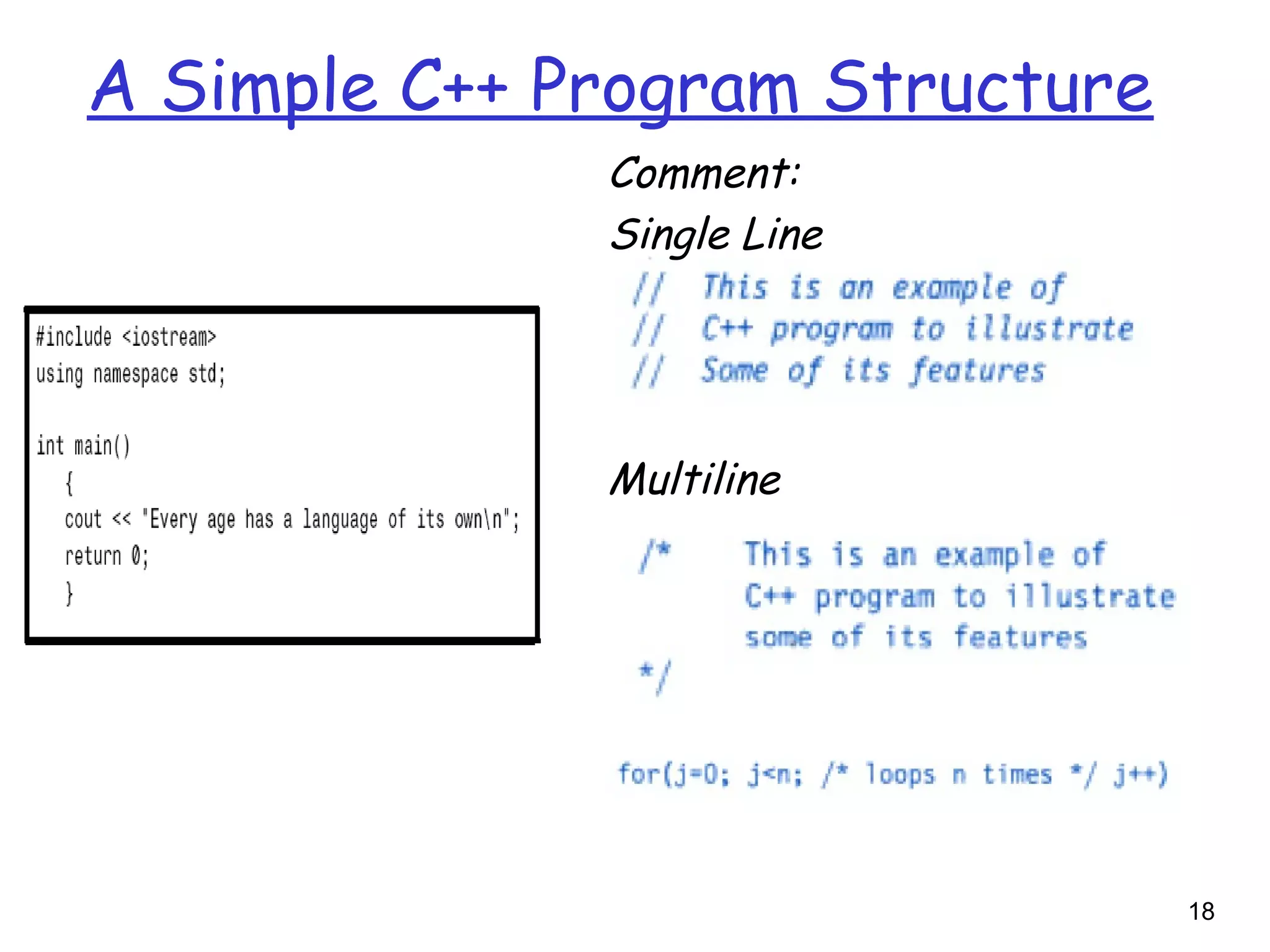



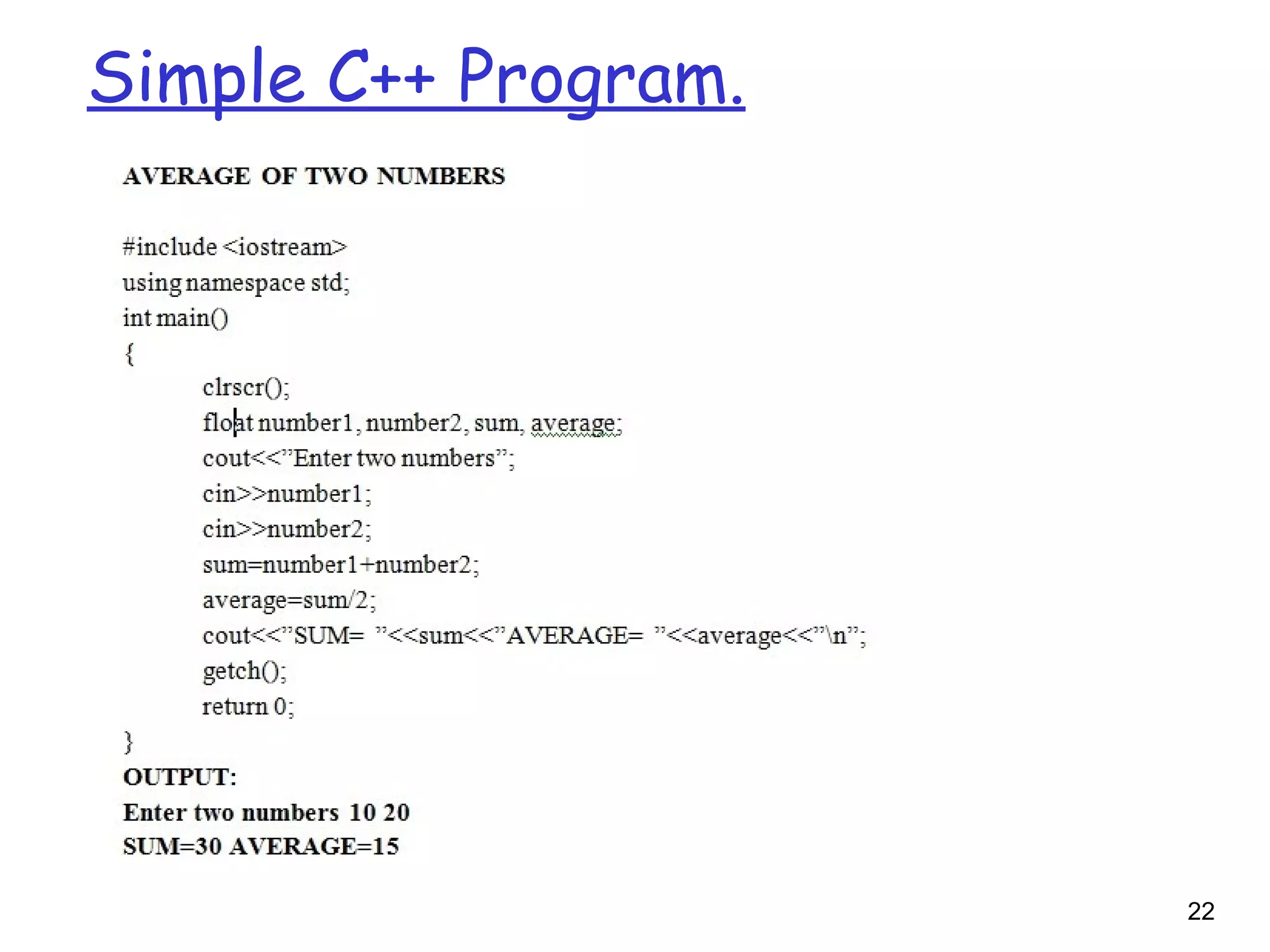

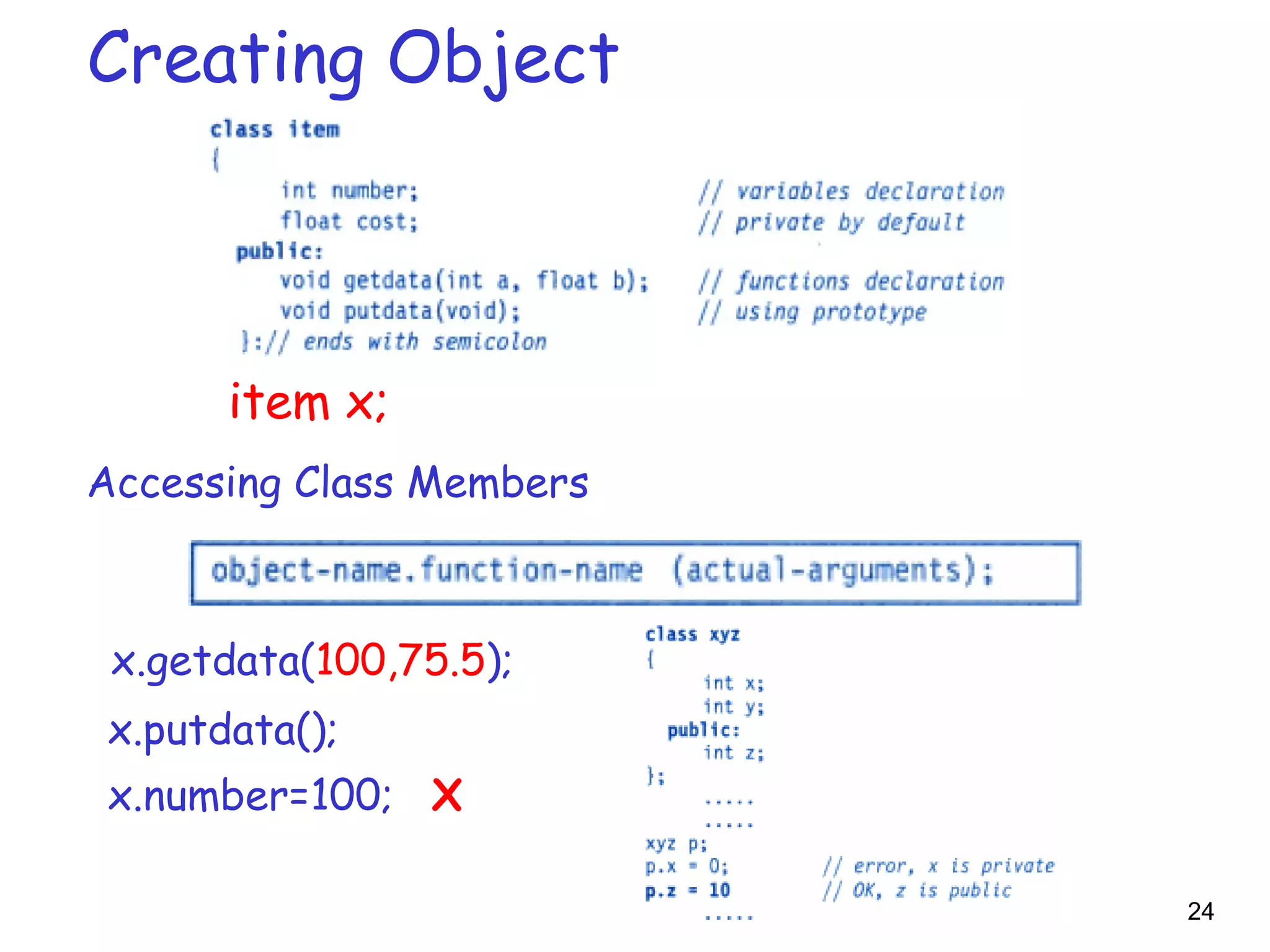

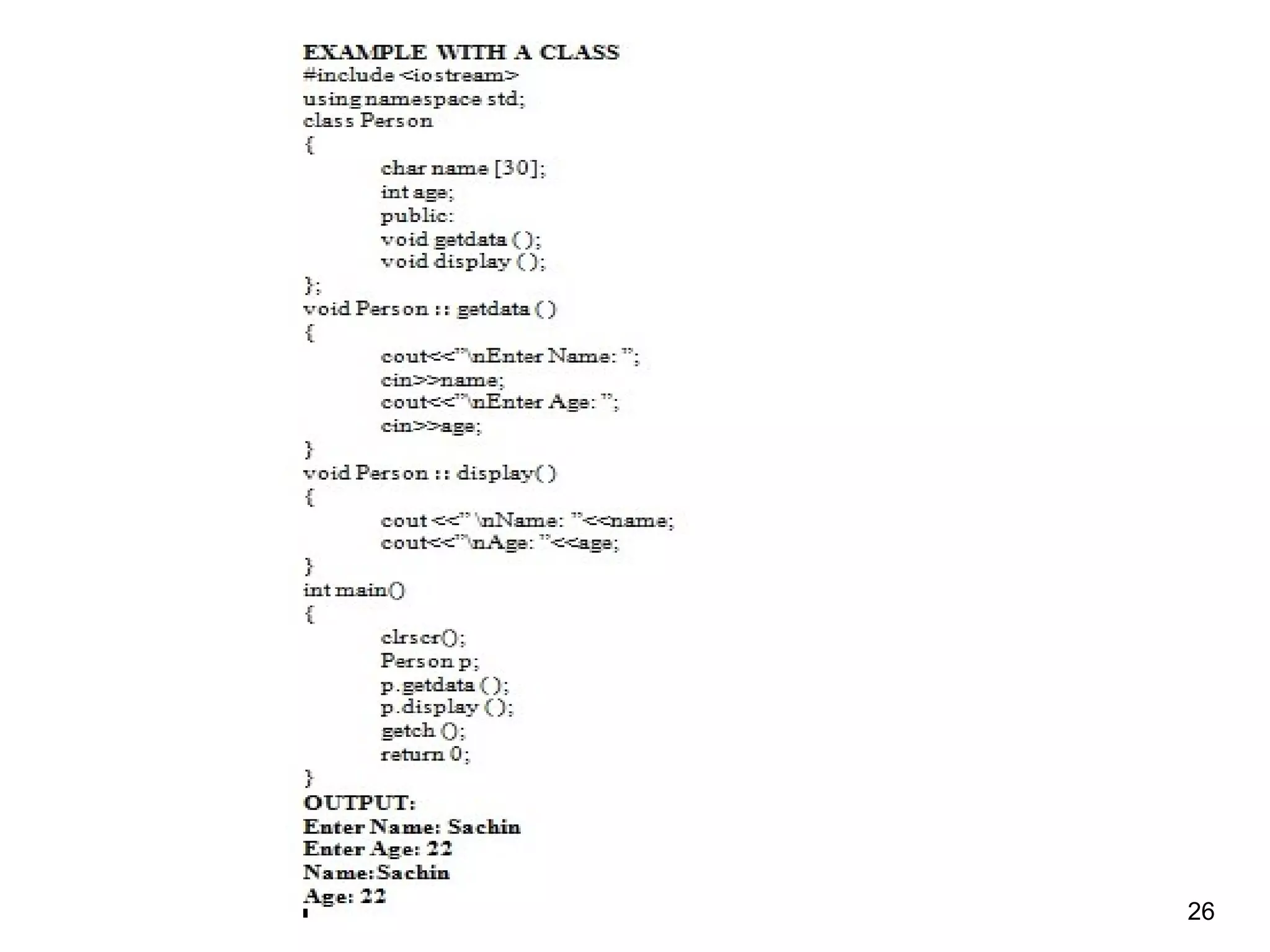
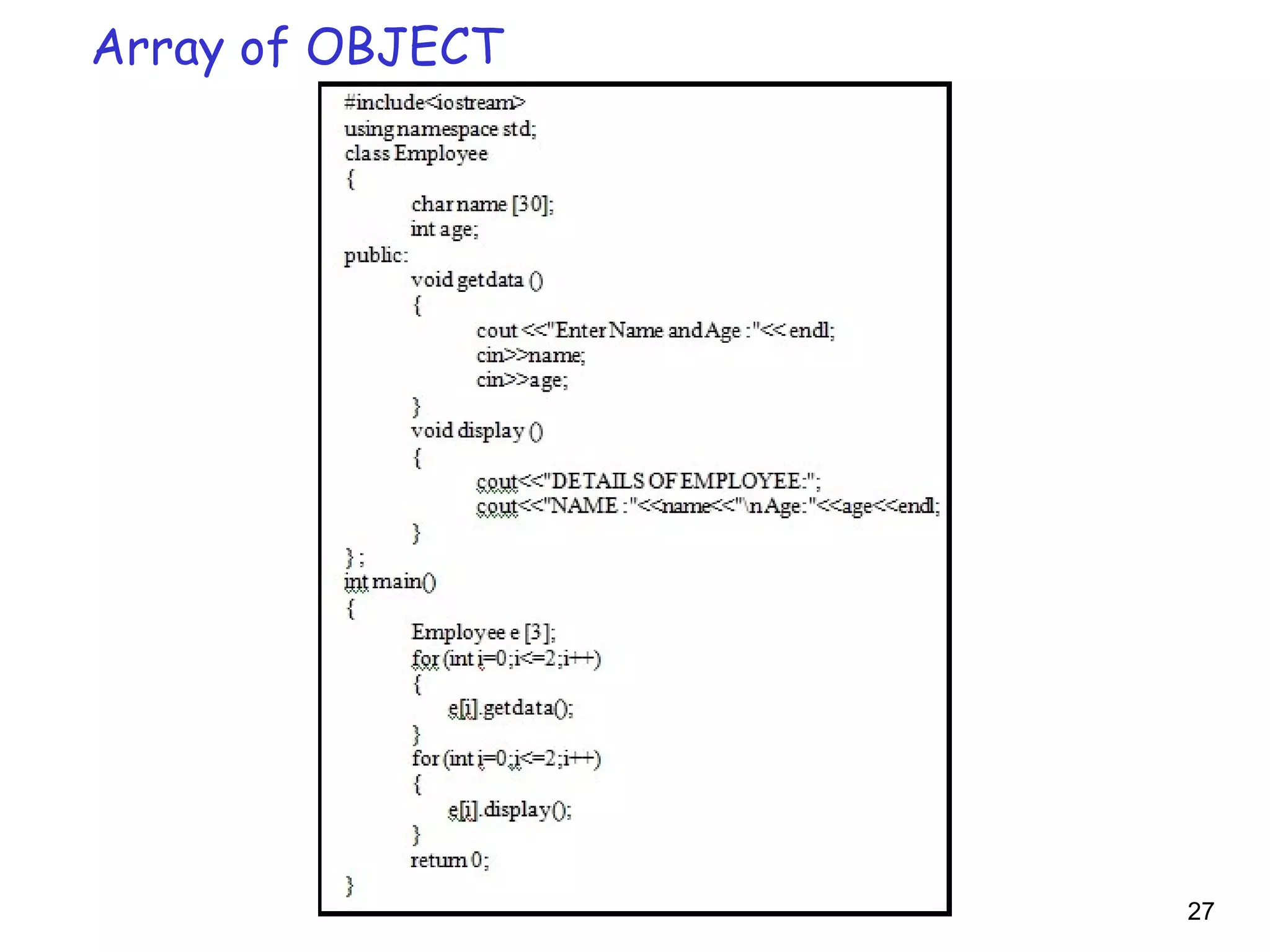

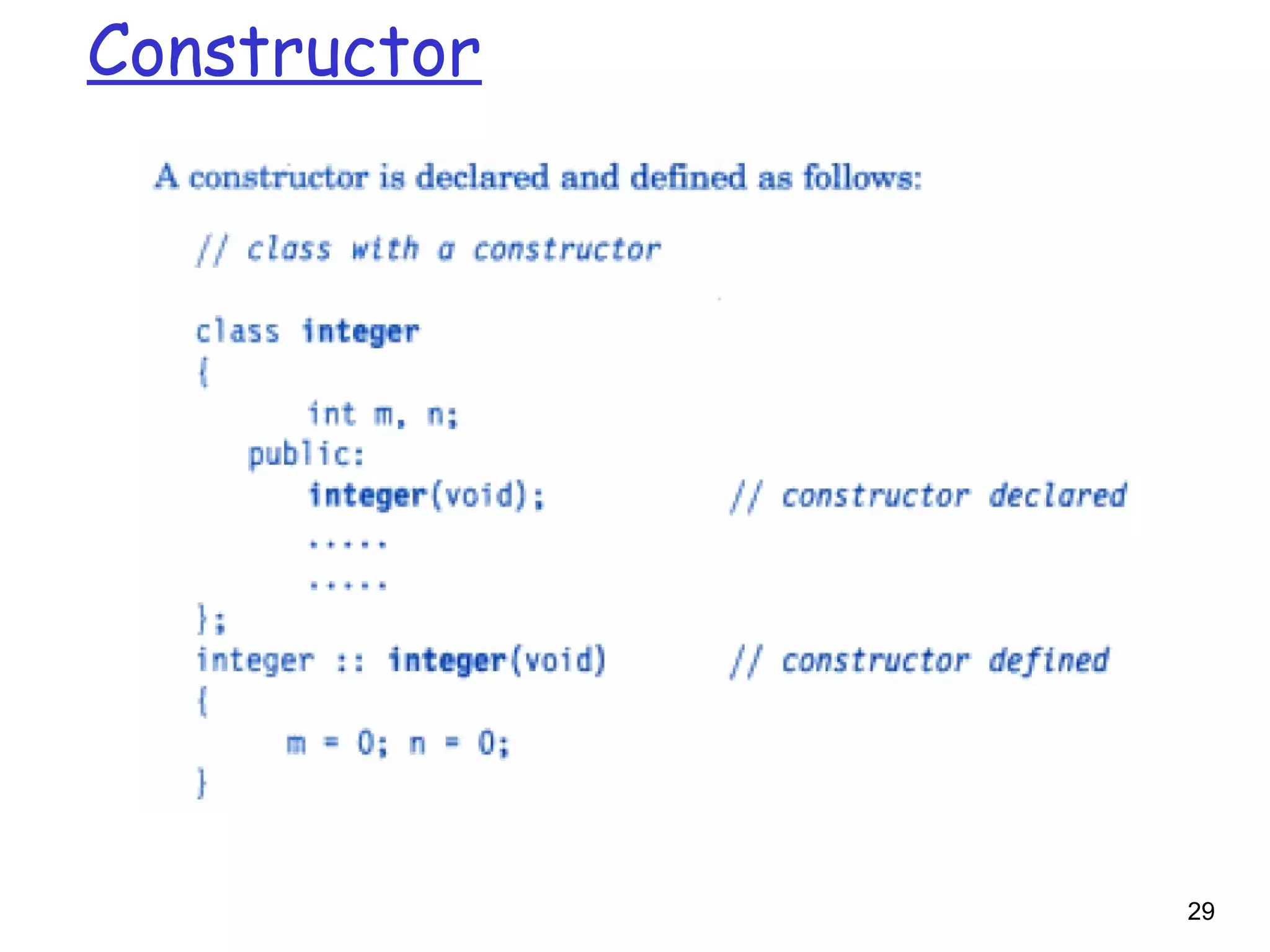

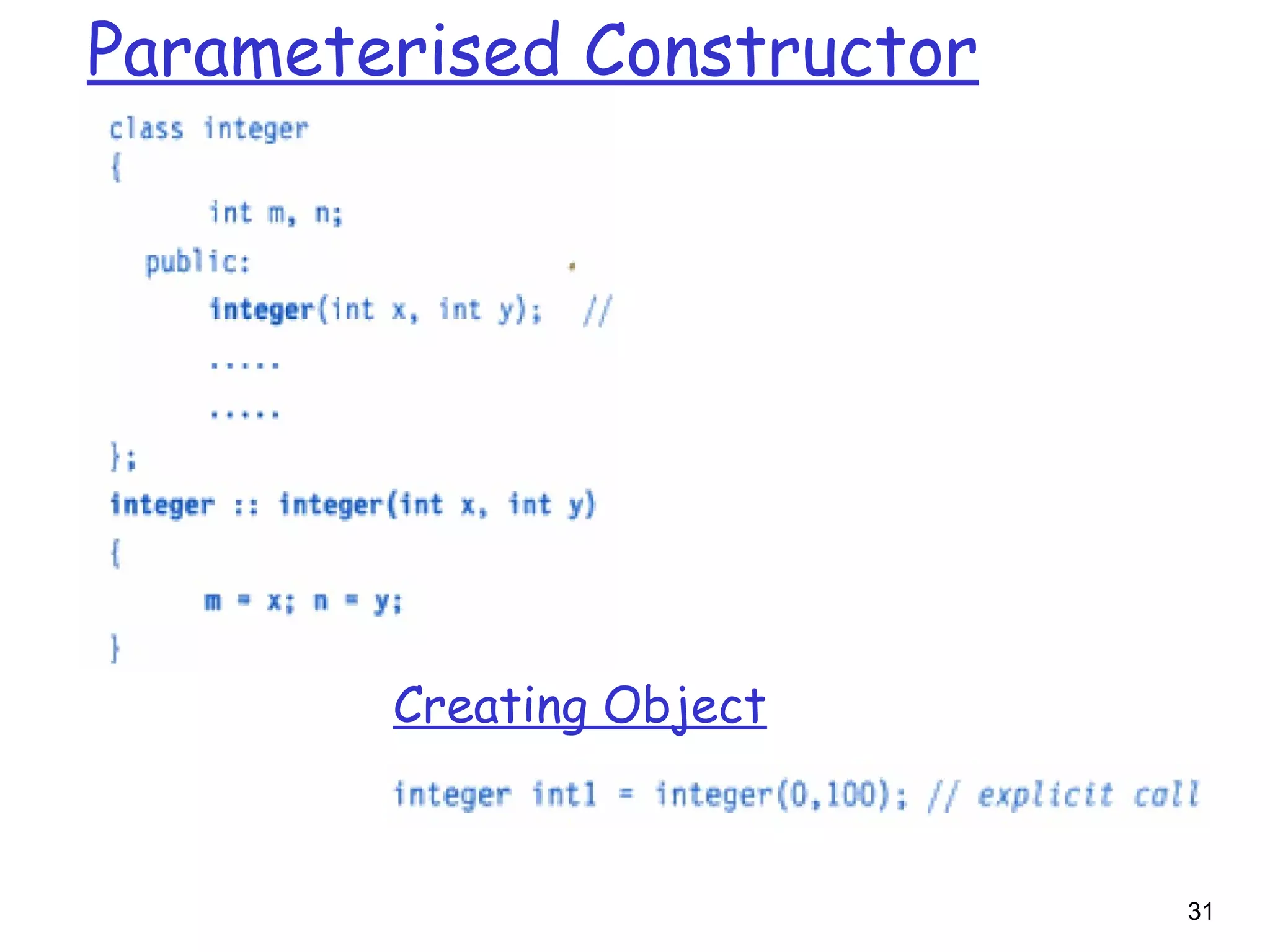
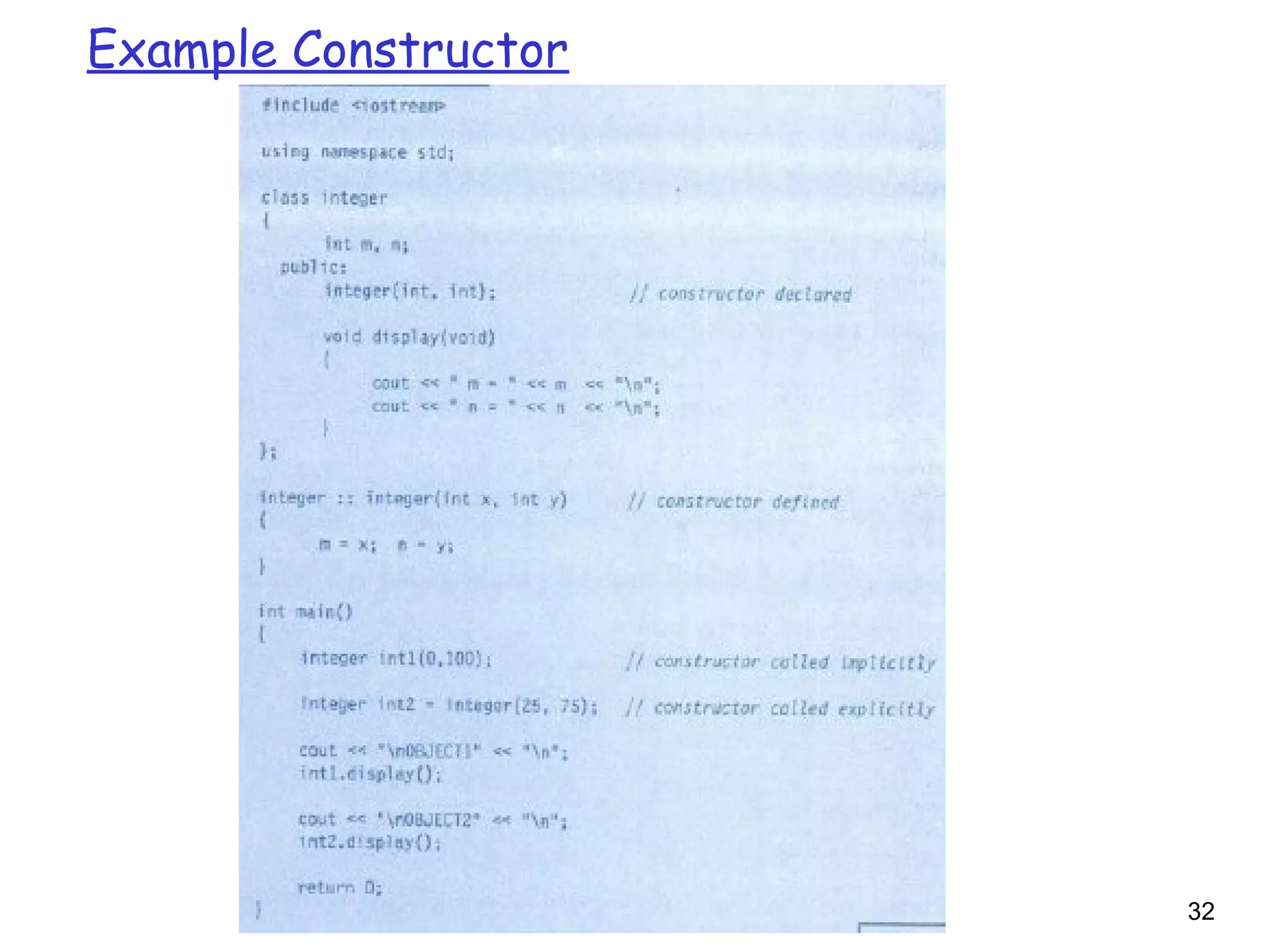
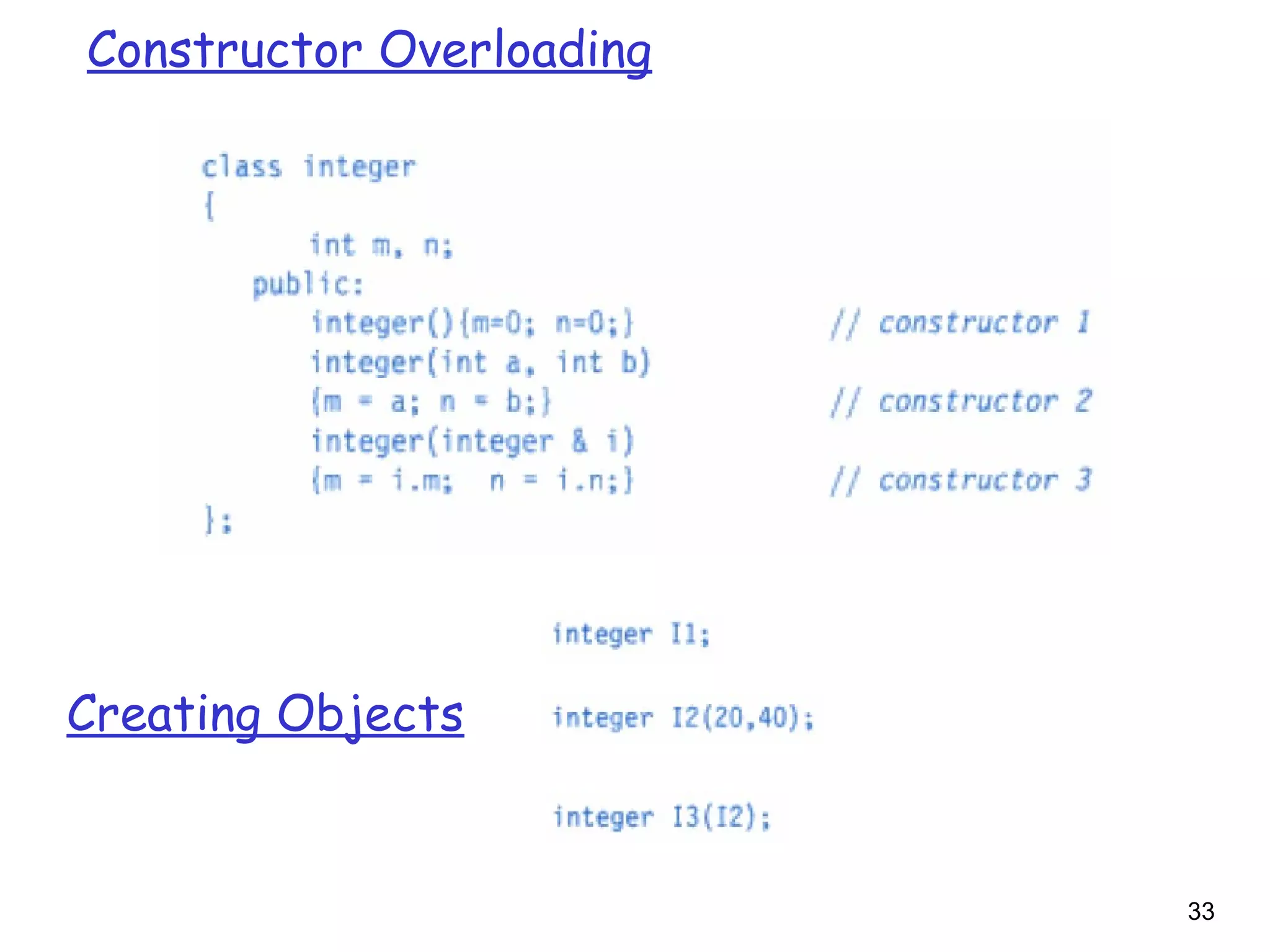

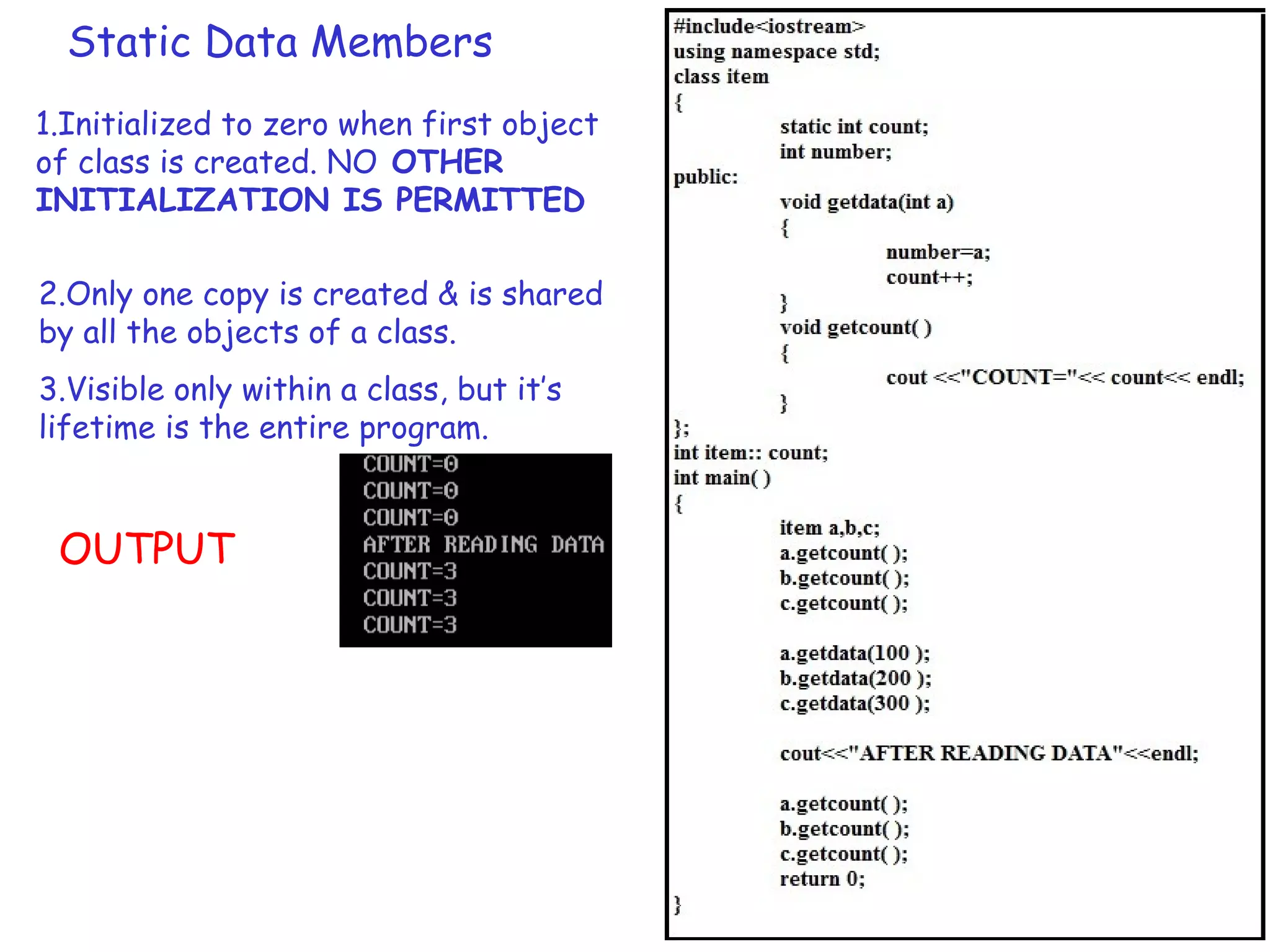
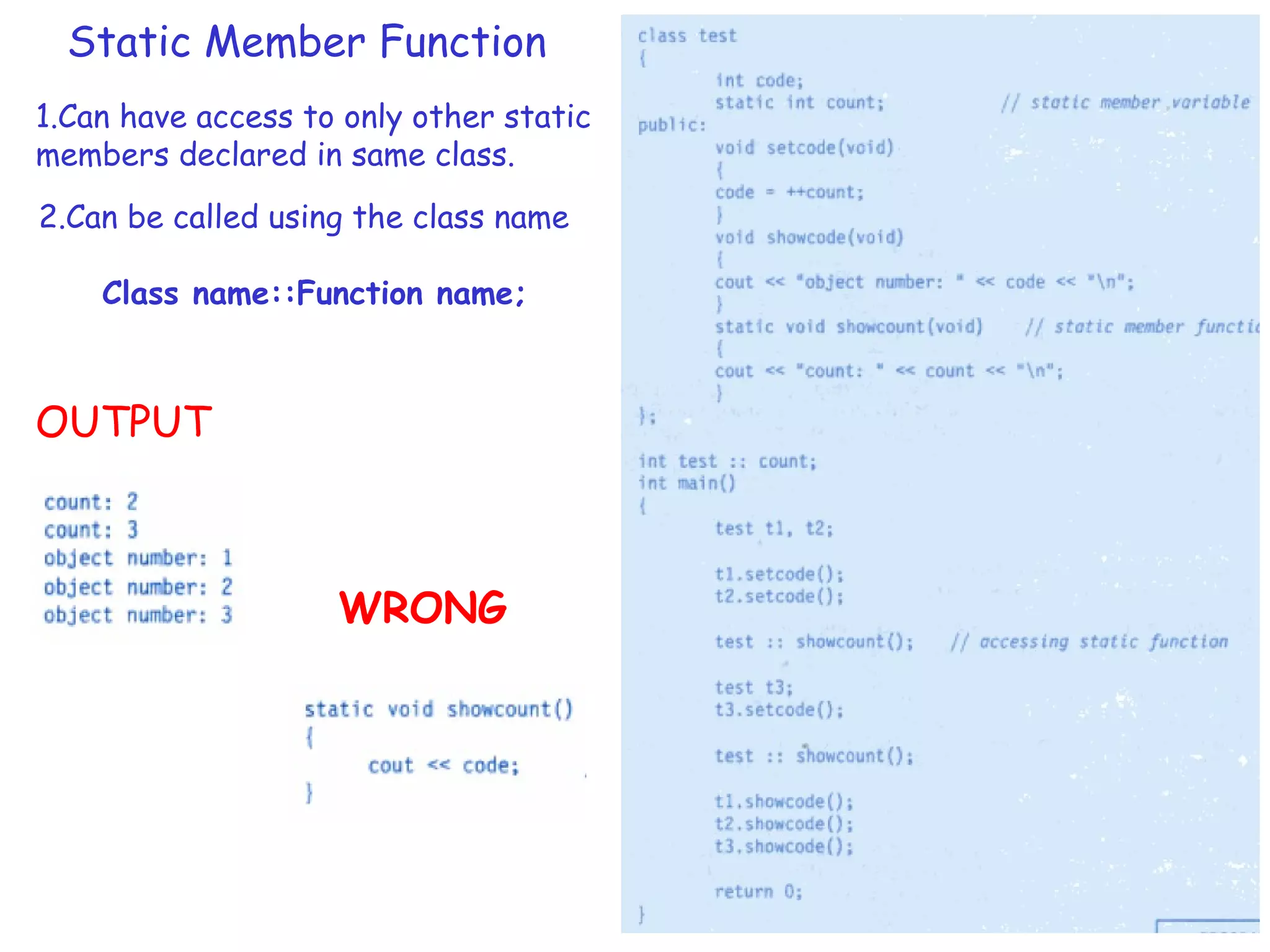

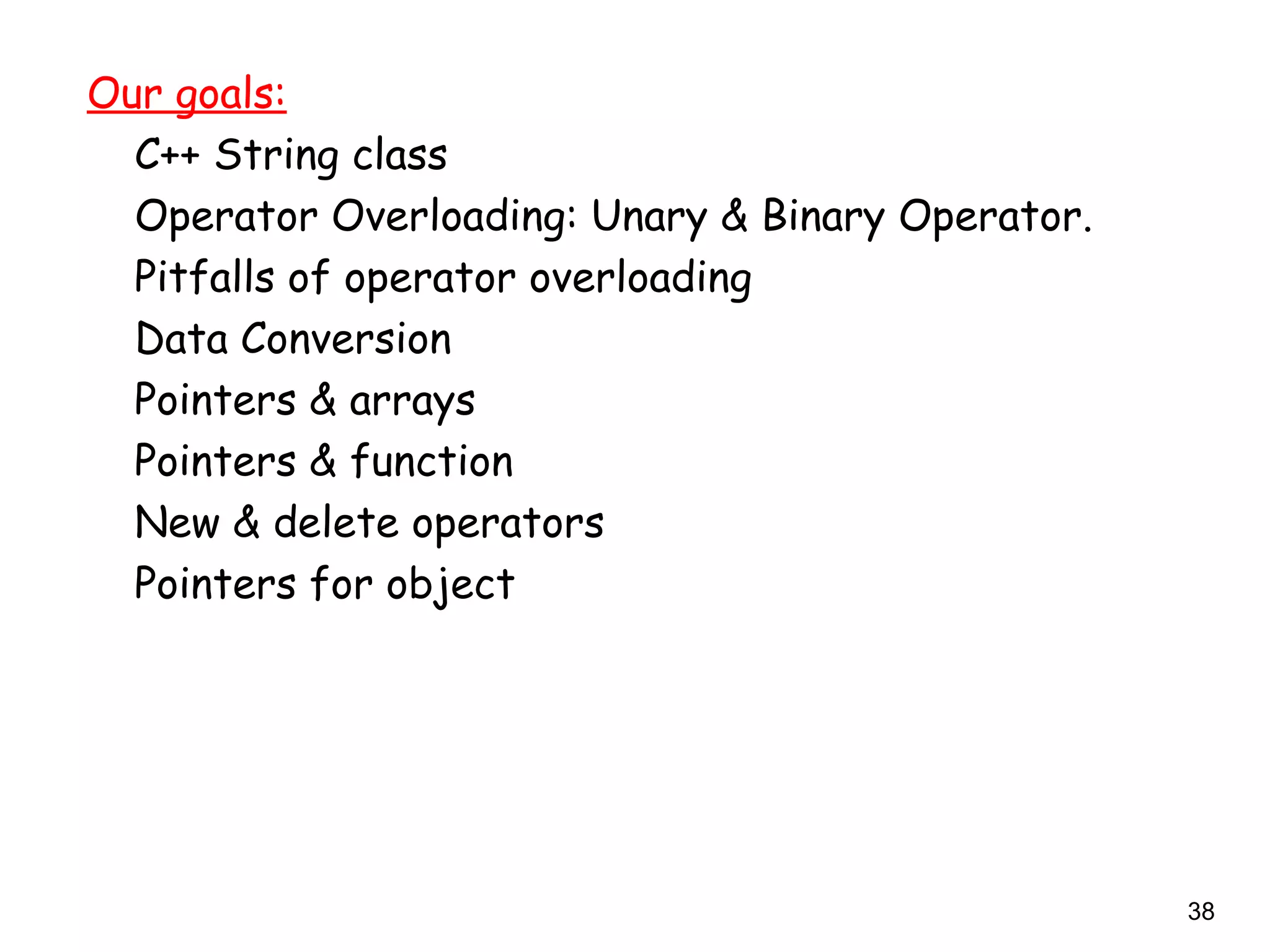
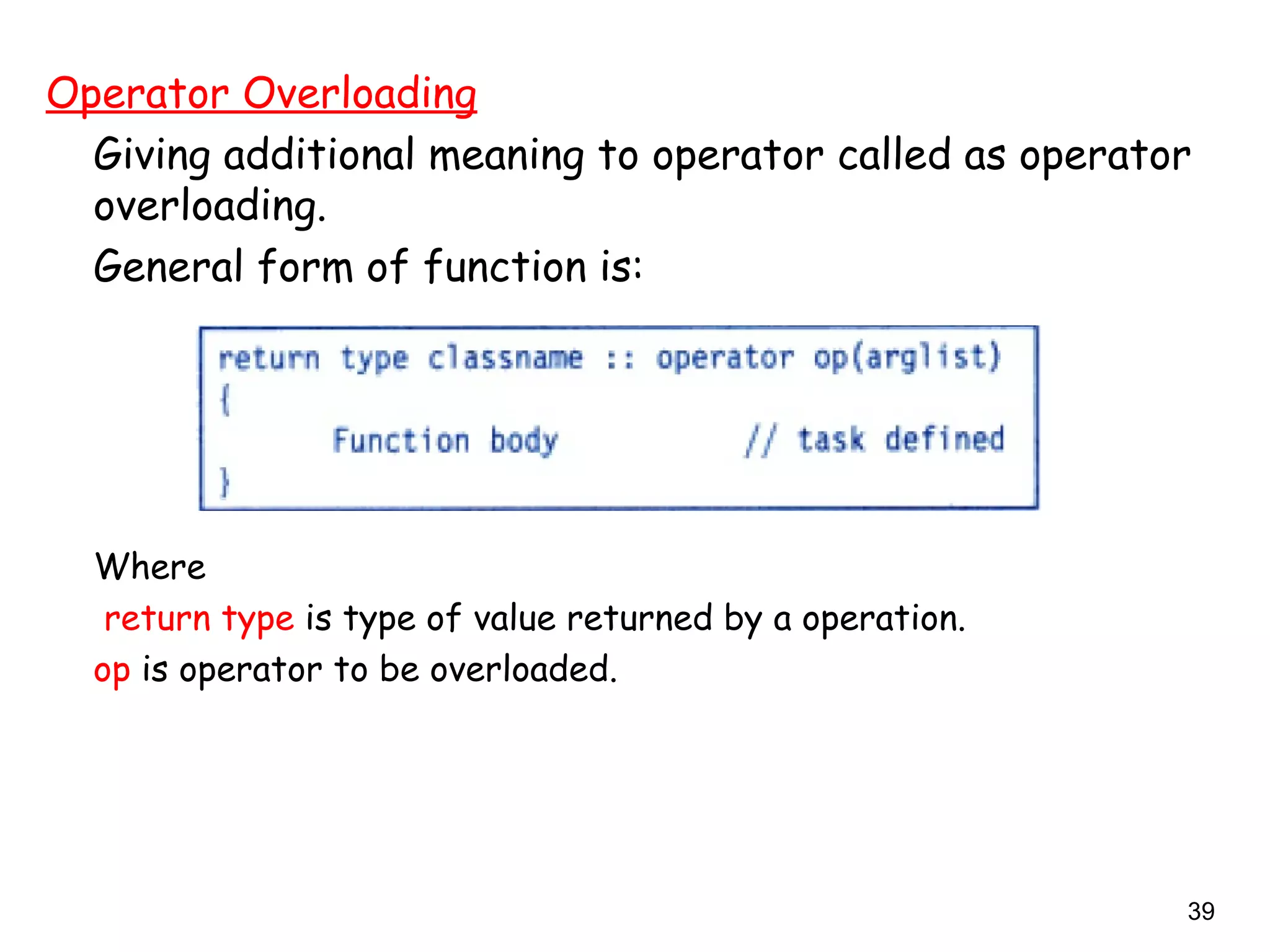

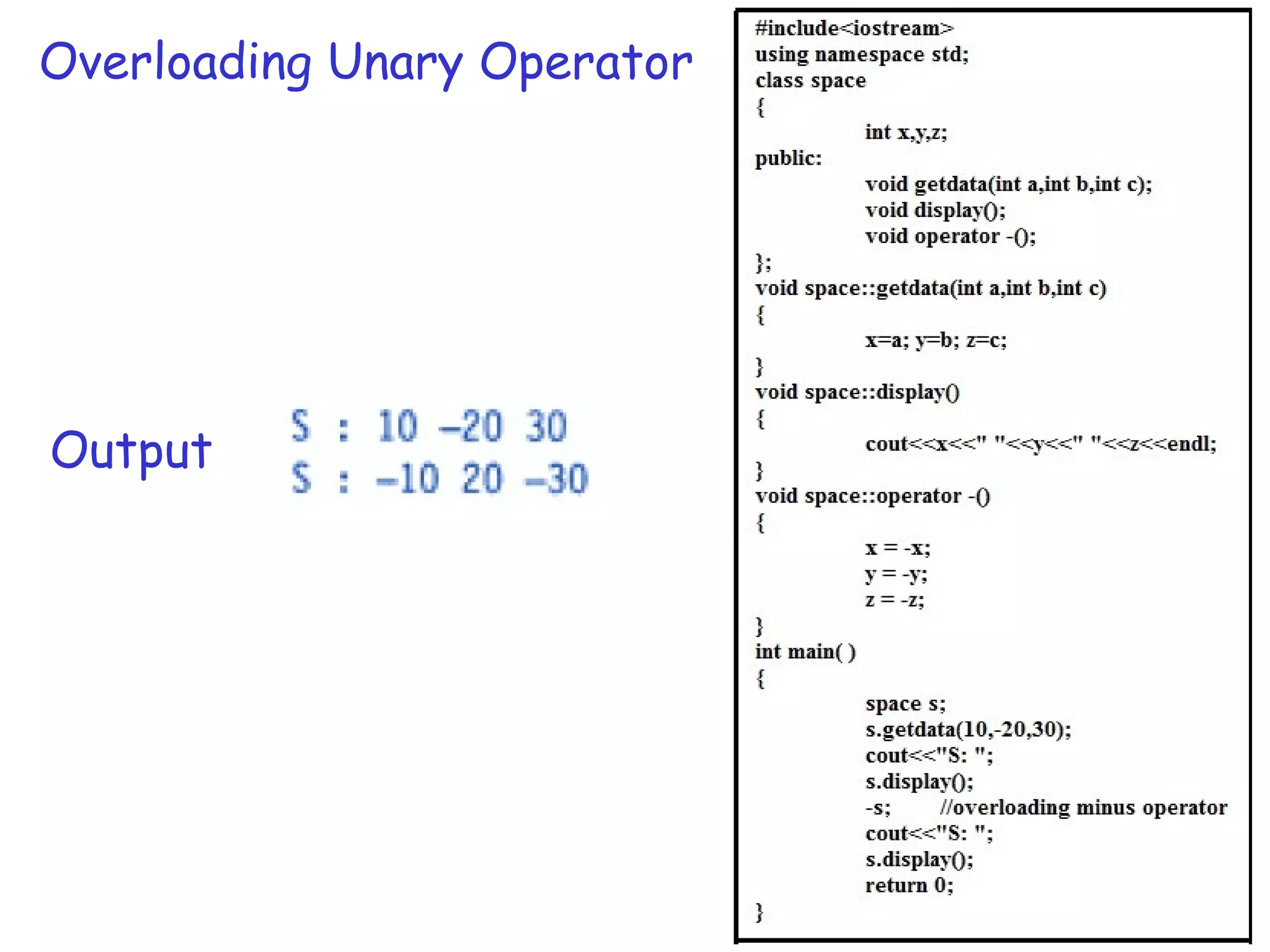



![Pointer Arithmetic
int main( )
{
int num[ ]={ 56,75,22,18,90 };
int *ptr;
int i;
cout<<“Array Elements Are:”<<endl;
for(i=0;i<5;i++)
{
cout<<num[ i ] <<endl;
}
ptr=num;
cout<<“VALUES OF PTR”<<*ptr;
ptr++;
cout<<“VALUES OF PTR++”<<*ptr;
ptr--;
cout<<“VALUES OF PTR--”<<*ptr;
ptr = ptr+2;
cout<<“VALUES OF PTR+2”<<*ptr;
ptr = ptr-1;
cout<<“VALUES OF PTR-2”<<*ptr;
ptr += 3;
cout<<“VALUES OF PTR+=3”<<*ptr;
ptr -= 2;
cout<<“VALUES OF PTR-=2”<<*ptr;
return 0;
}
Output
Array Elements Are:
56
75
22
18
90
VALUE OF PTR 56
VALUE OF PTR++ 75
VALUE OF PTR-- 56
VALUE OF PTR+2 22
VALUE OF PTR-1 75
VALUE OF PTR+=3 90
VALUE OF PTR-=2 22](https://image.slidesharecdn.com/oot-160725075650/75/Object-Oriented-Technologies-45-2048.jpg)
![Pointers with arrays
//A Program to sum all elements of array
int main( )
{
int number [ 50 ] *ptr;
int n,i, sum=0;
cout<<“Enter the values:”<<endl;
for( i=0;i<5;i++)
{
cin>>number[ i ] ;
}
ptr=number;
for( i=0;i<5;i++)
{
sum=sum + *ptr;
ptr++;
}
cout<<“Sum of array element is: ”<<sum;
return 0;
}
//Sum of even Numbers:
for( i=0;i<5;i++)
{
if( *ptr%2==0)
{
sum=sum+*ptr;
ptr++;
}
}](https://image.slidesharecdn.com/oot-160725075650/75/Object-Oriented-Technologies-46-2048.jpg)
![Pointers to object #include <iostream>
using namespace std;
class Person
{
char name [30];
int age;
public:
void getdata ( );
void display ( );
};
void Person :: getdata ( )
{
cout<<”Enter Name:n”;
cin>>name;
cout<<”Enter Age:n”;
cin>>age;
}
void Person :: display( )
{
cout<<” Name: ”<<name;
cout<<”Age: ”<<age;
}
int main( )
{
Person p;
p.getdata ( );
p.display ( );
Person *ptr=&p;
ptr->getdata( );
ptr->display( );
return 0;
}](https://image.slidesharecdn.com/oot-160725075650/75/Object-Oriented-Technologies-47-2048.jpg)

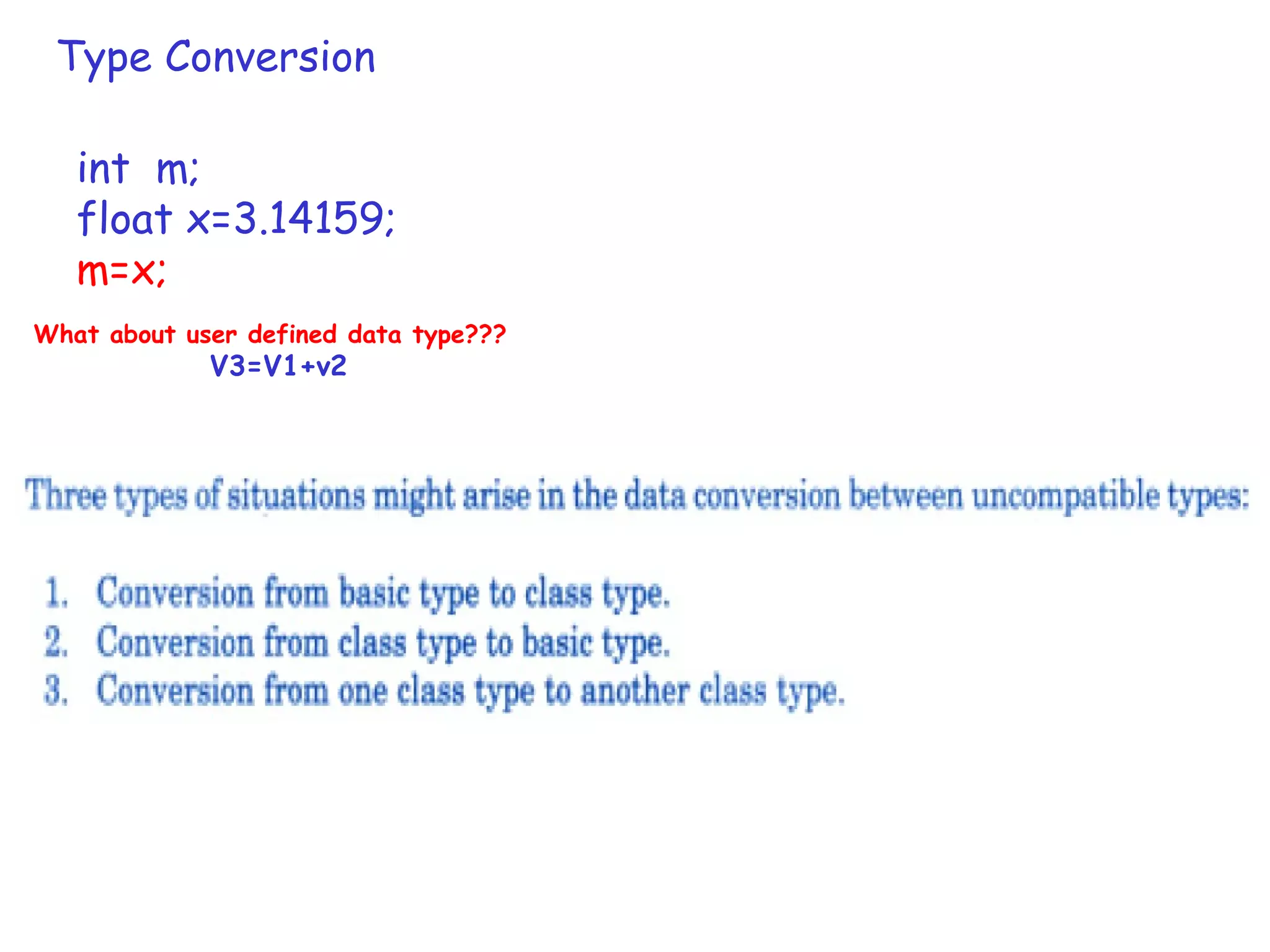

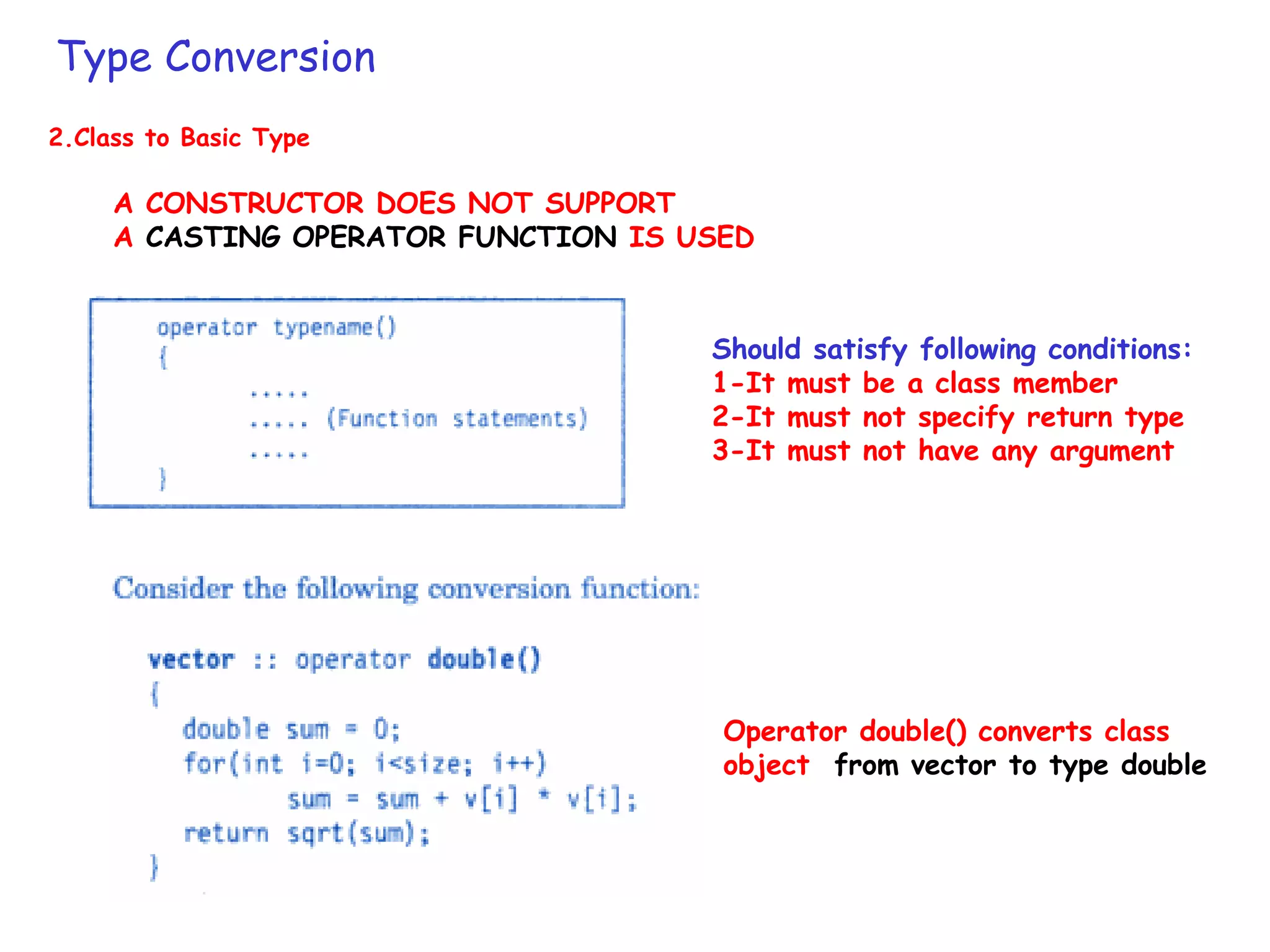

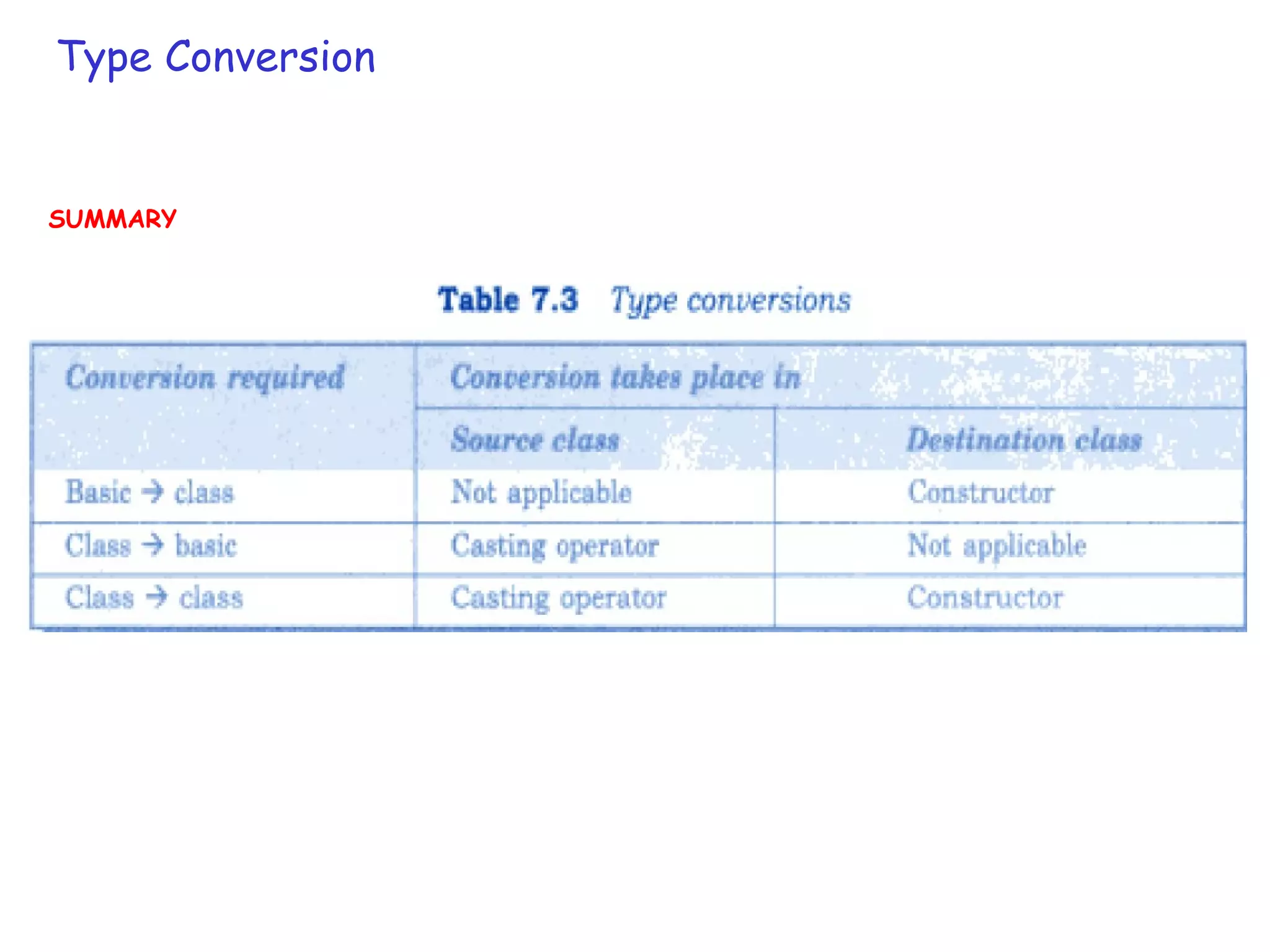





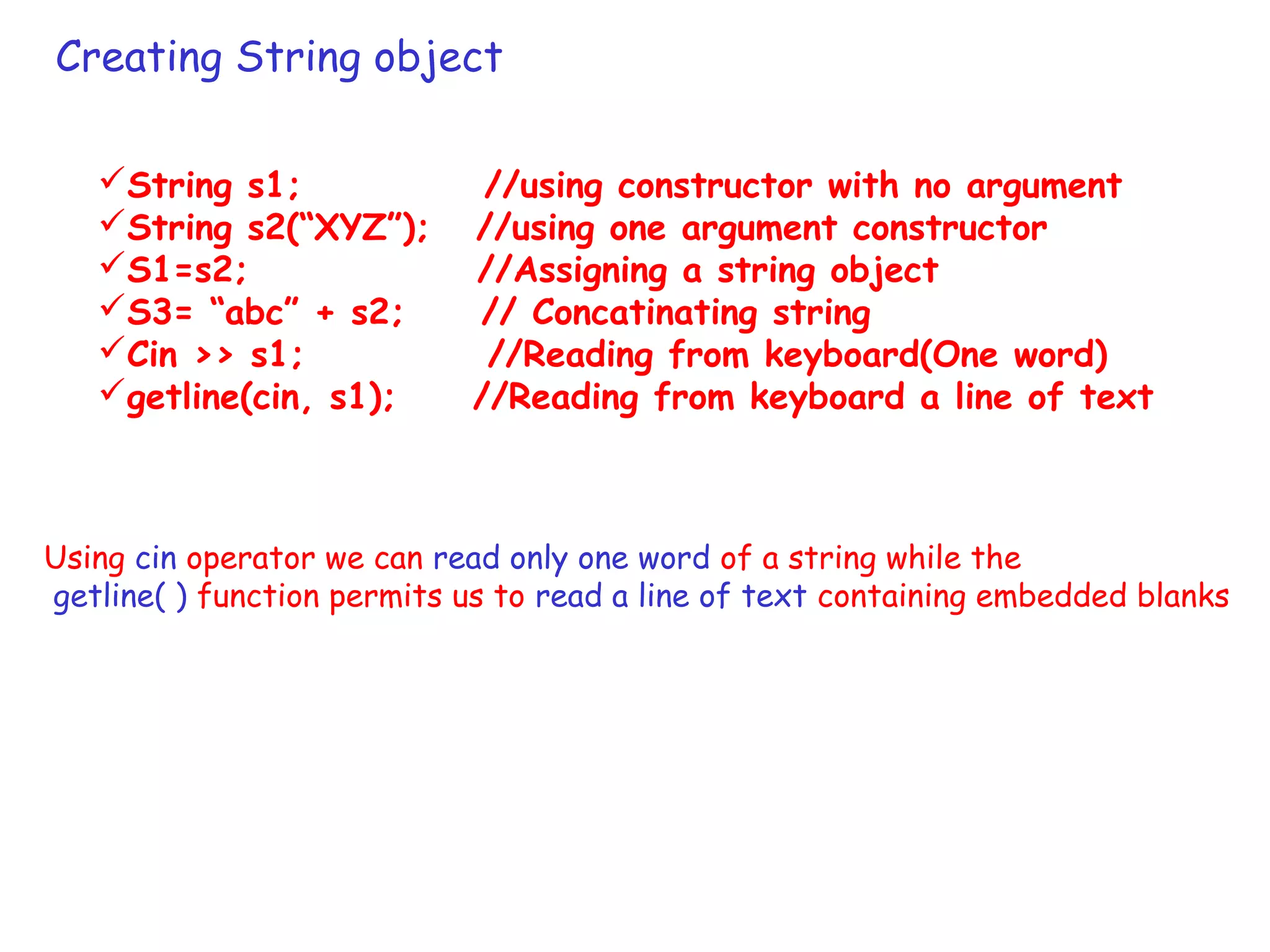

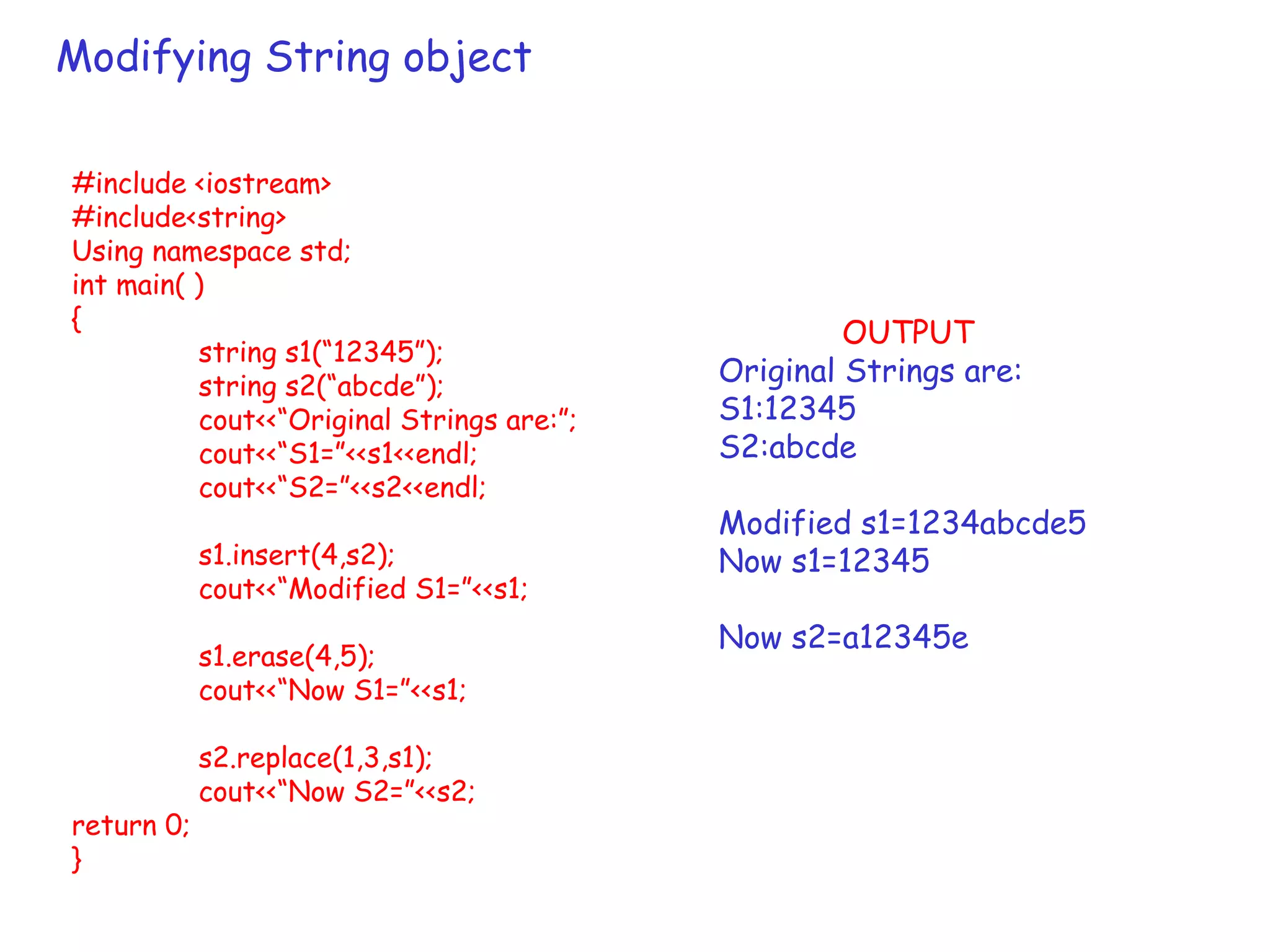

![Concatenation of two string using operator overloading
#include <iostream>
#include<string>
Using namespace std;
Class string
{
char str [50];
public:
string( )
{
strcpy (str, “ ”);
}
string( char s[ ])
{
strcpy (str, s);
}
void display( )
{
cout<<str<<endl;
}
string operator +( string ss)
{
string temp;
strcpy(temp.str, str);
strcat(temp.str,ss.str);
return temp;
}
};
int main( )
{
string s1=“n Merry Christmas”;
string s2=“ Happy New year“;
string s3;
s1.display( ); s2.display( ); s3.display( );
s3=s1+s2;
S3.display( );
return o;
}
OUTPUT
Merry Christmas
Happy New year
Merry Christmas Happy New year](https://image.slidesharecdn.com/oot-160725075650/75/Object-Oriented-Technologies-63-2048.jpg)


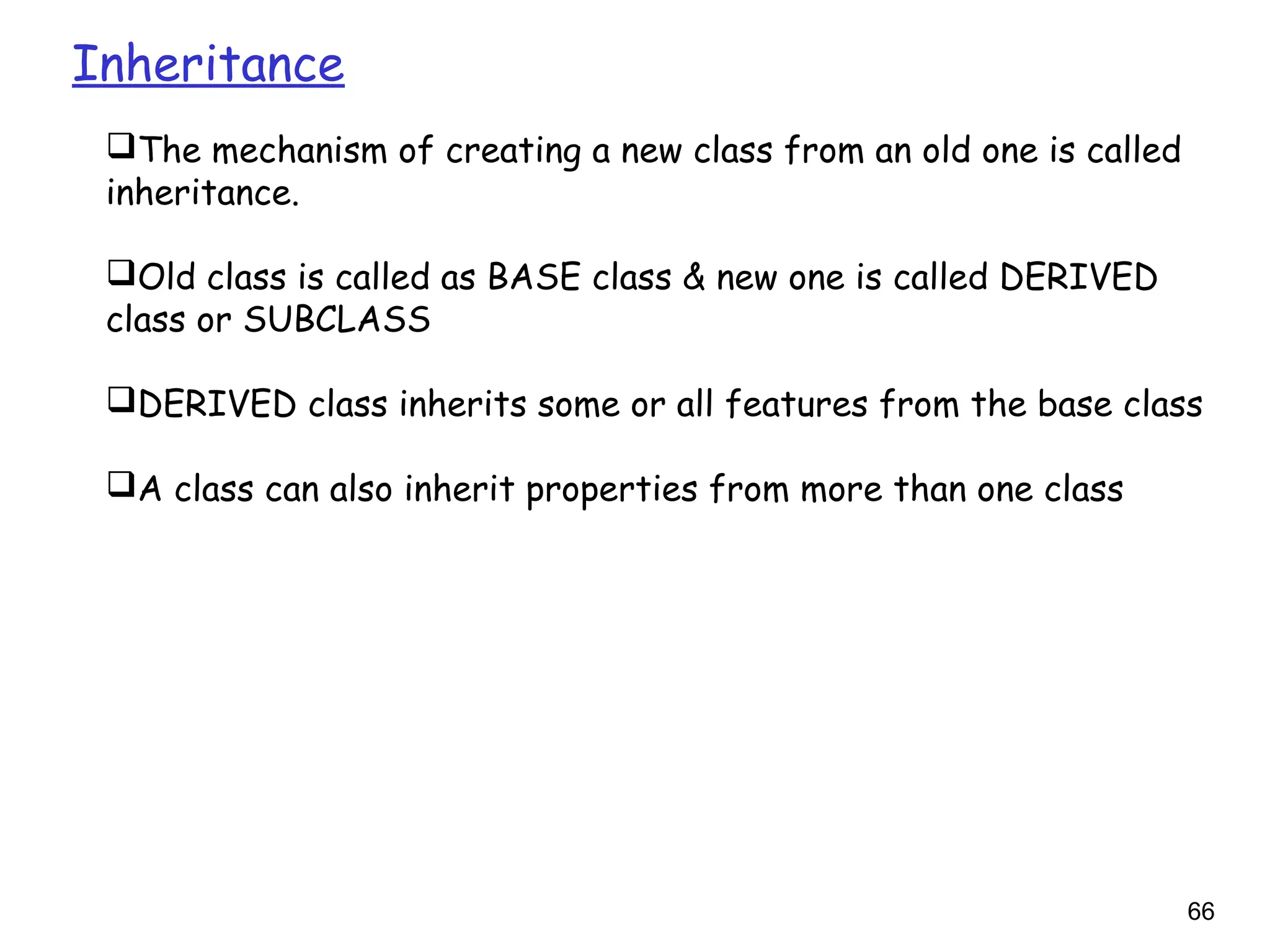


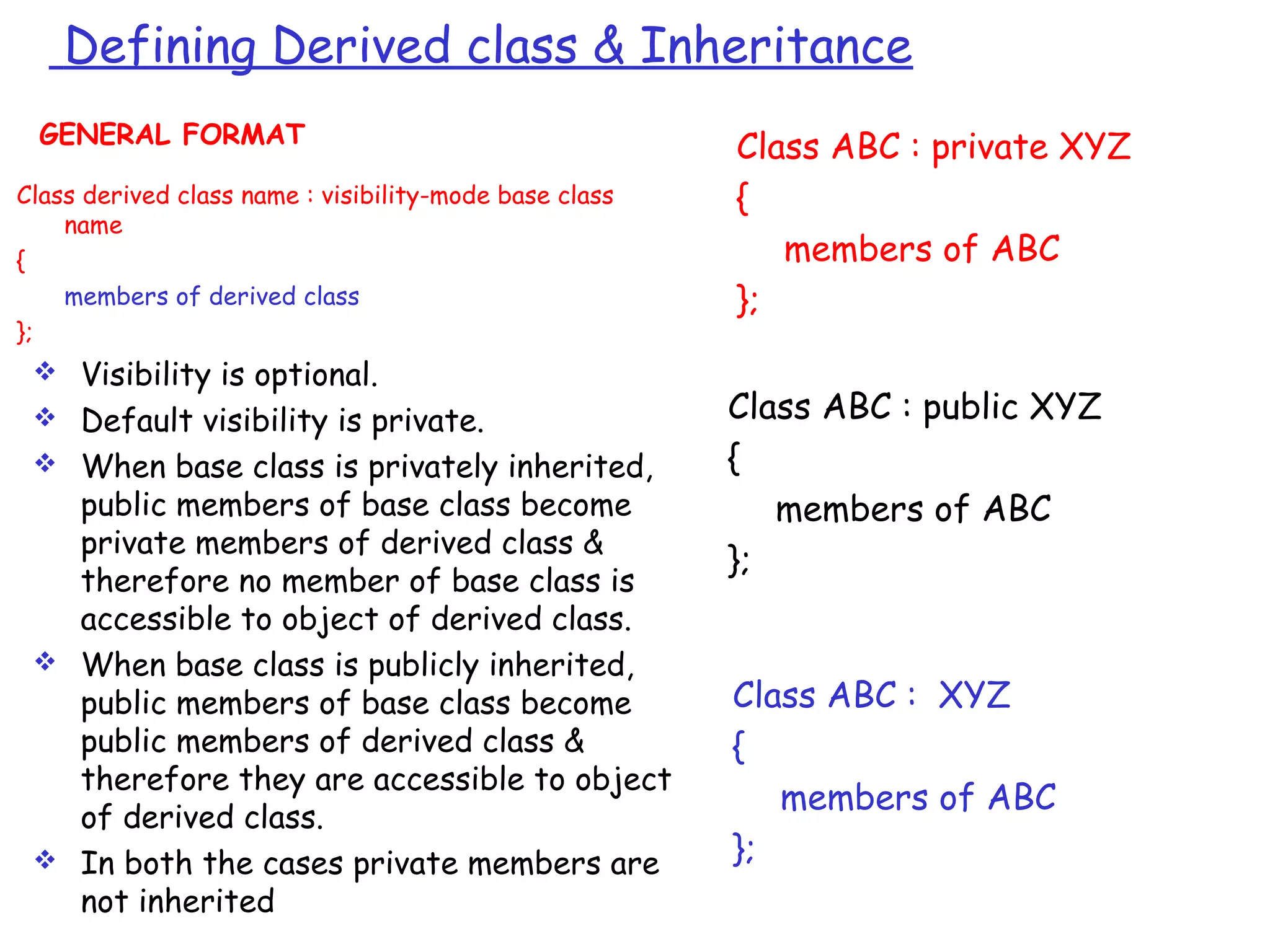
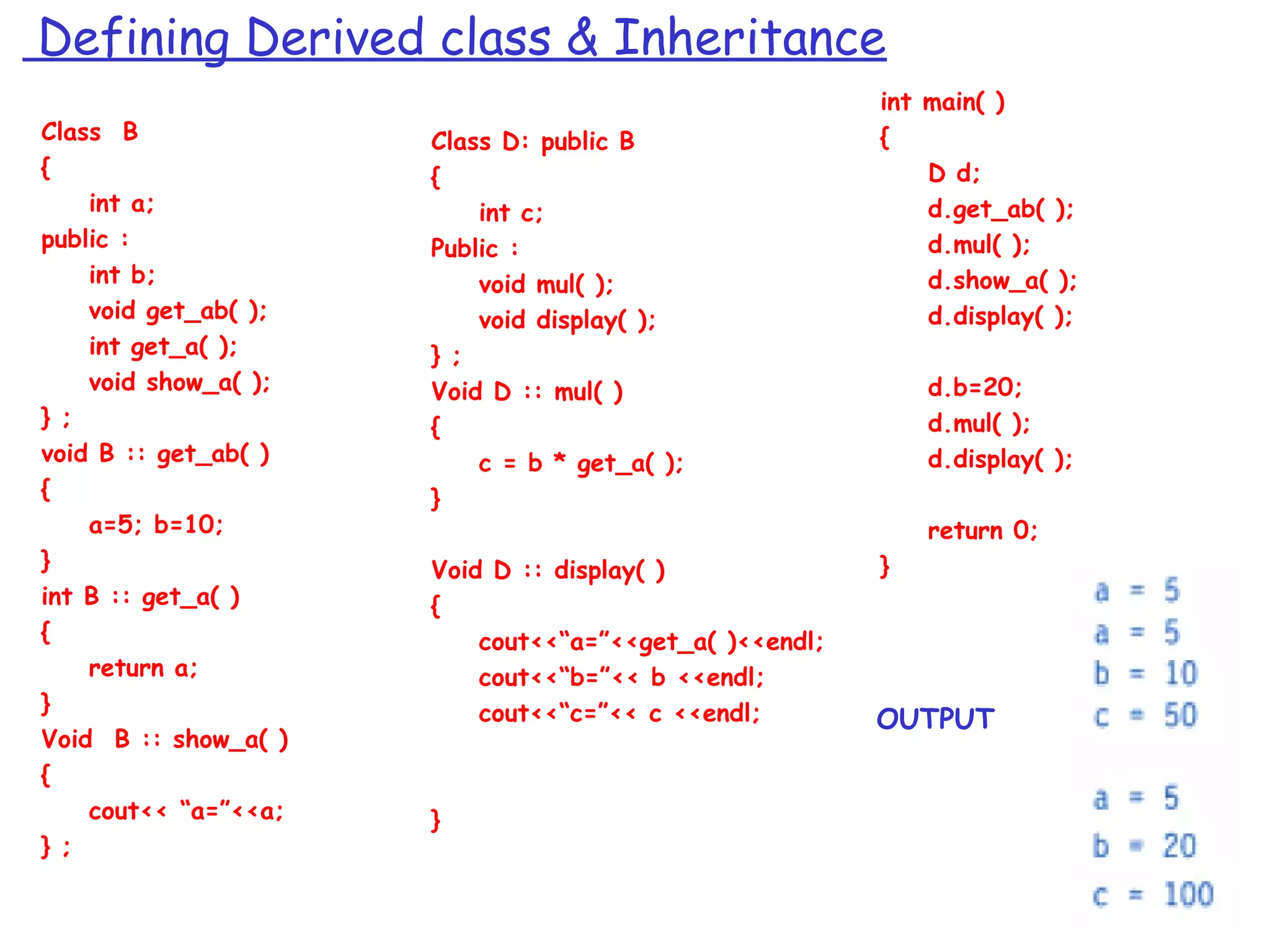
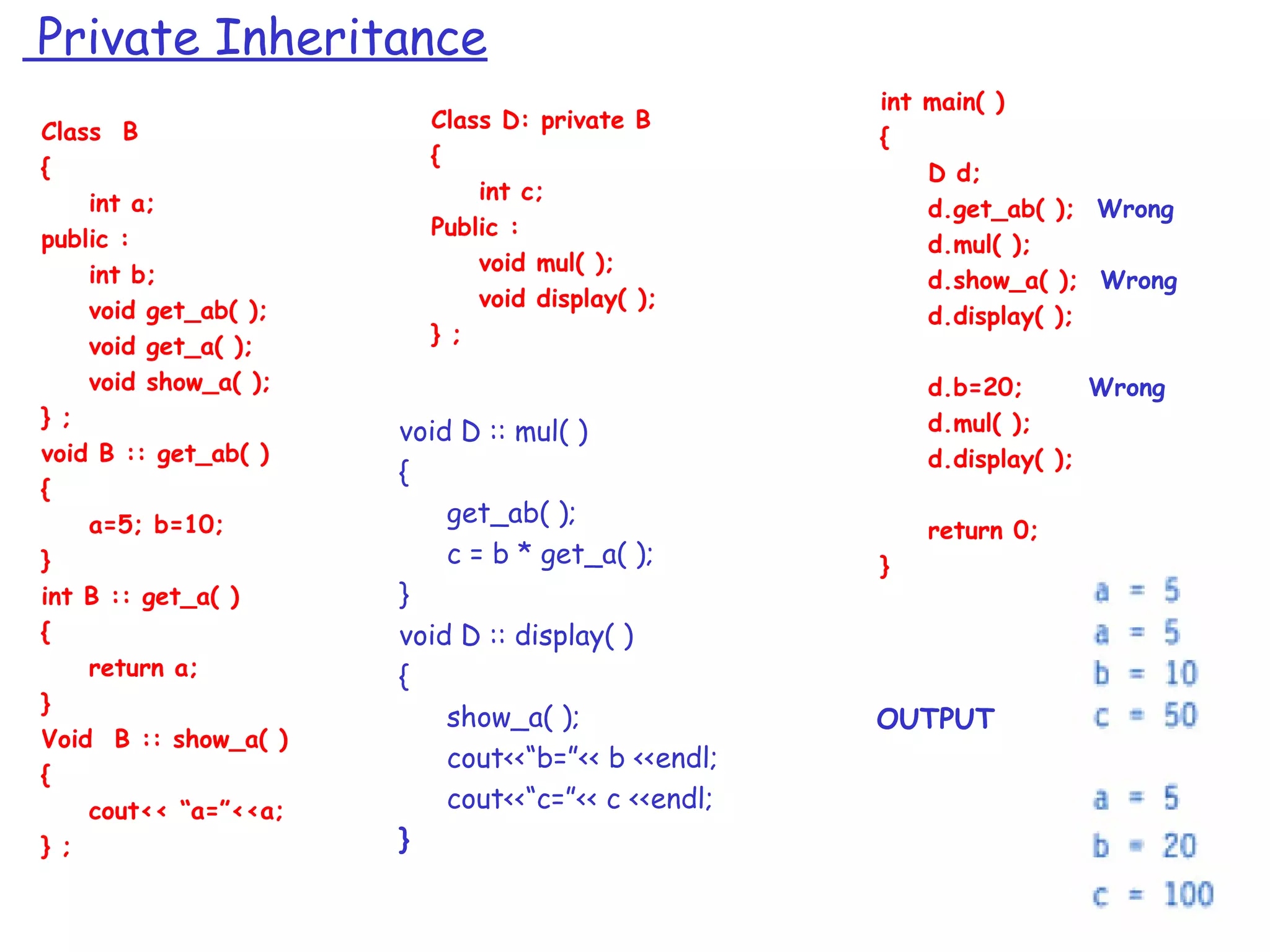
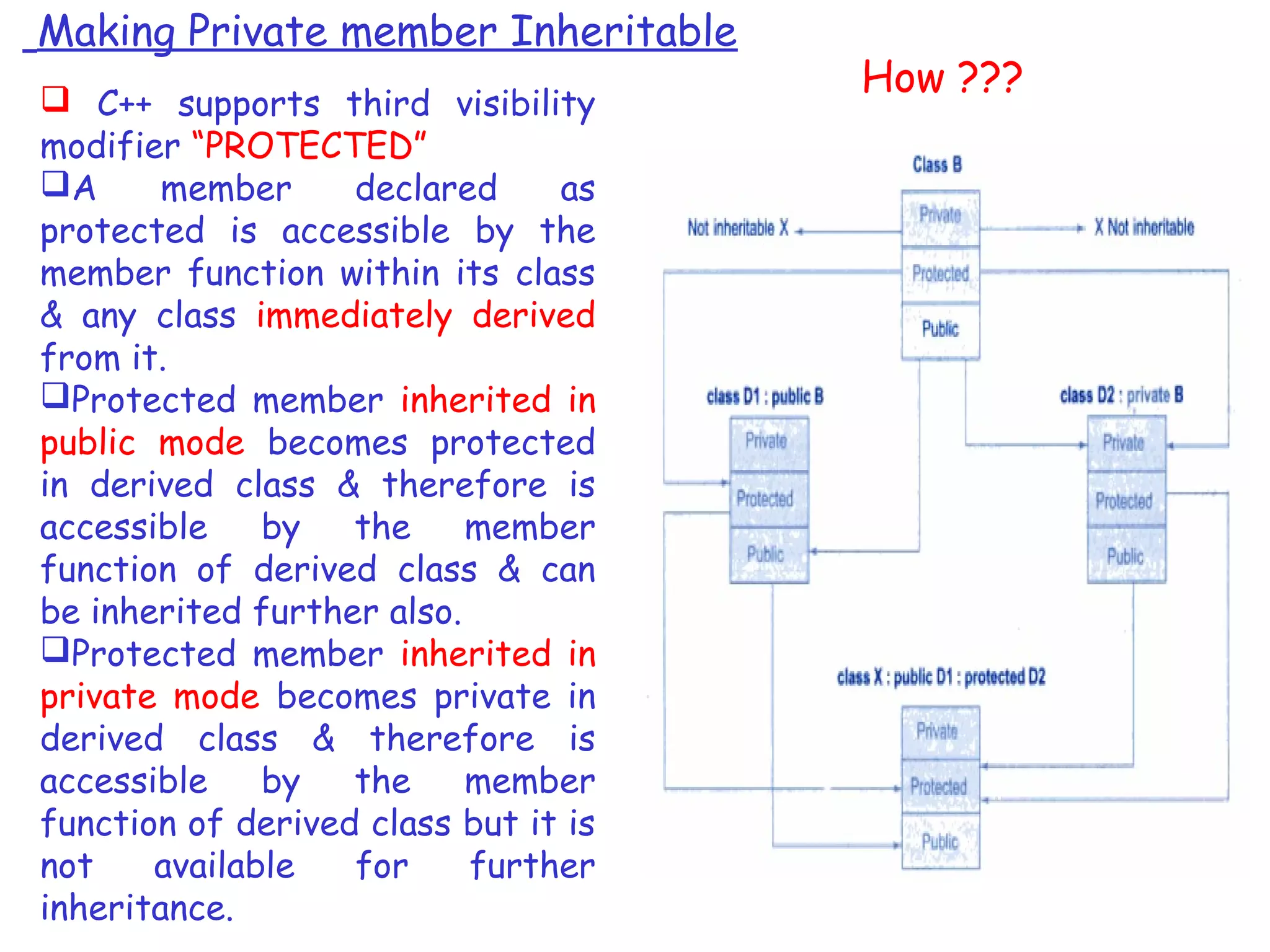

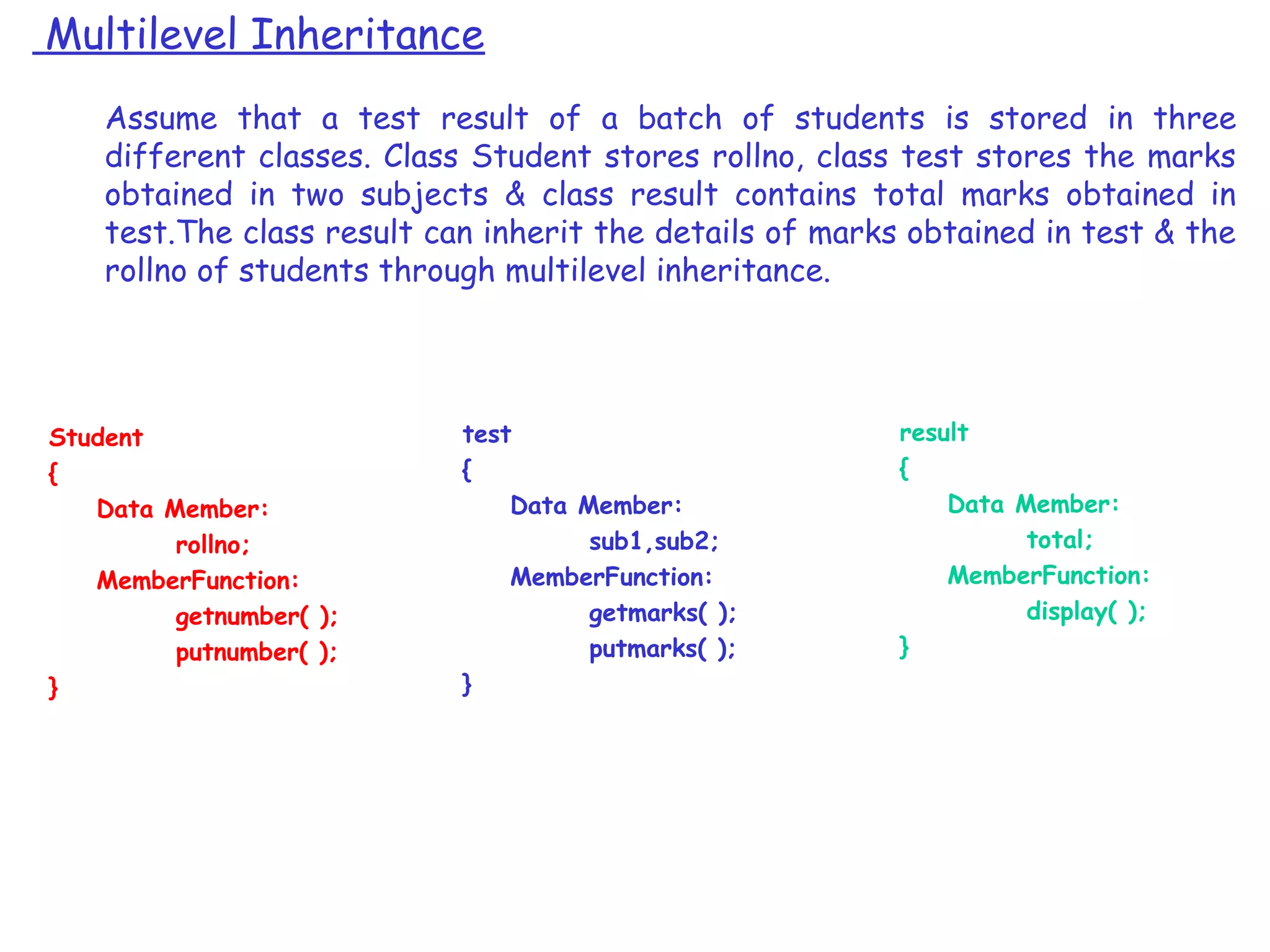

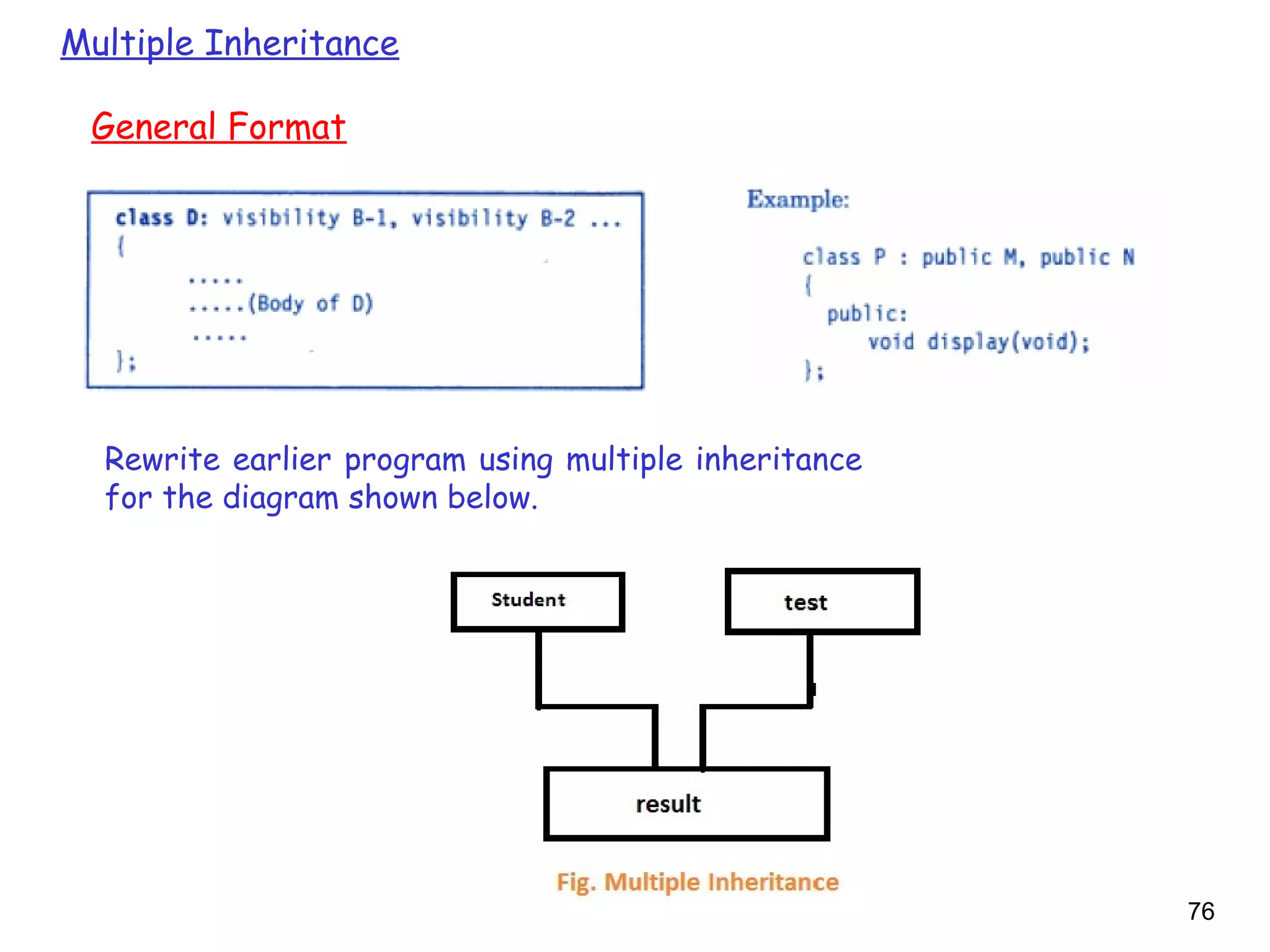


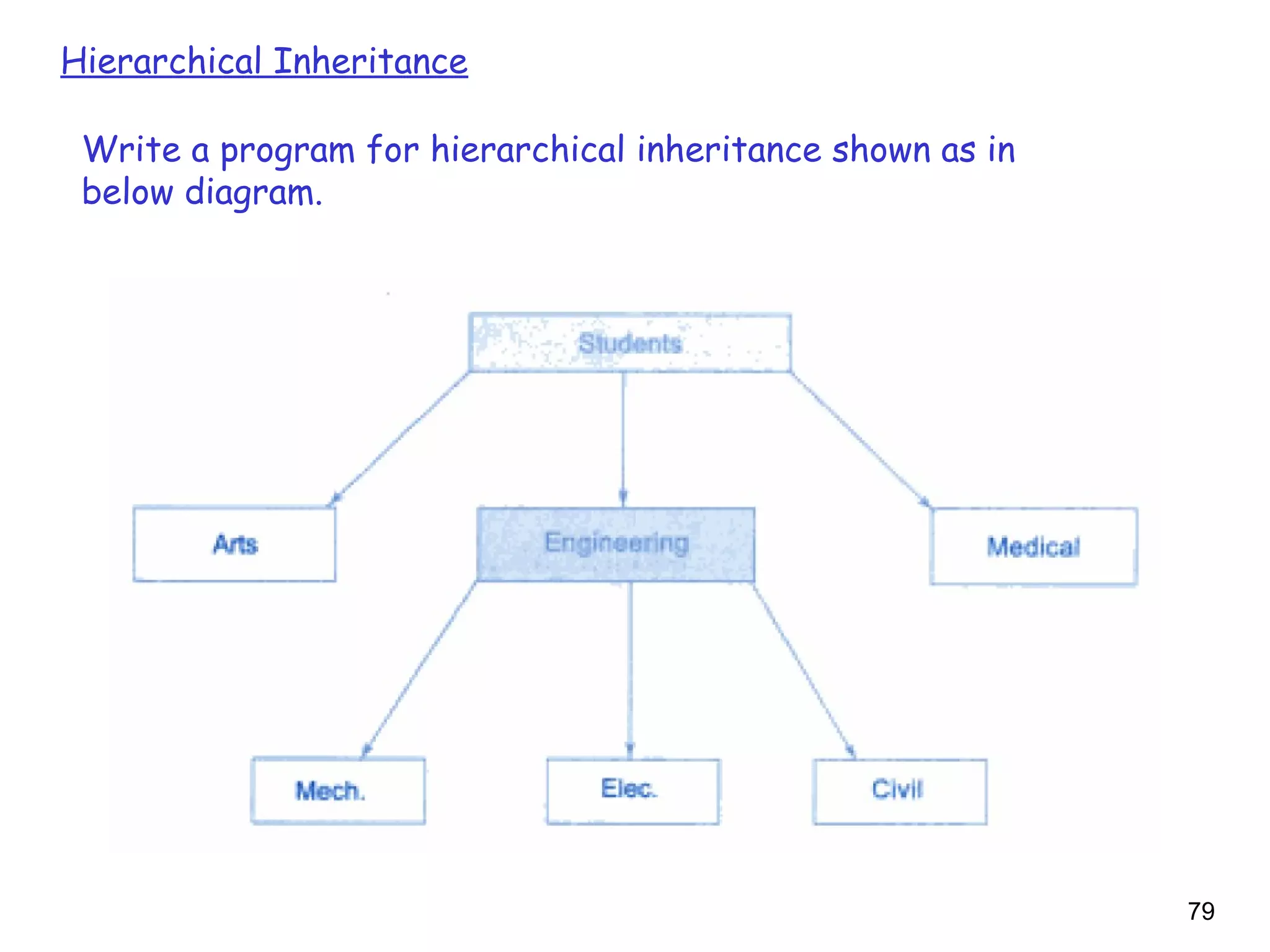
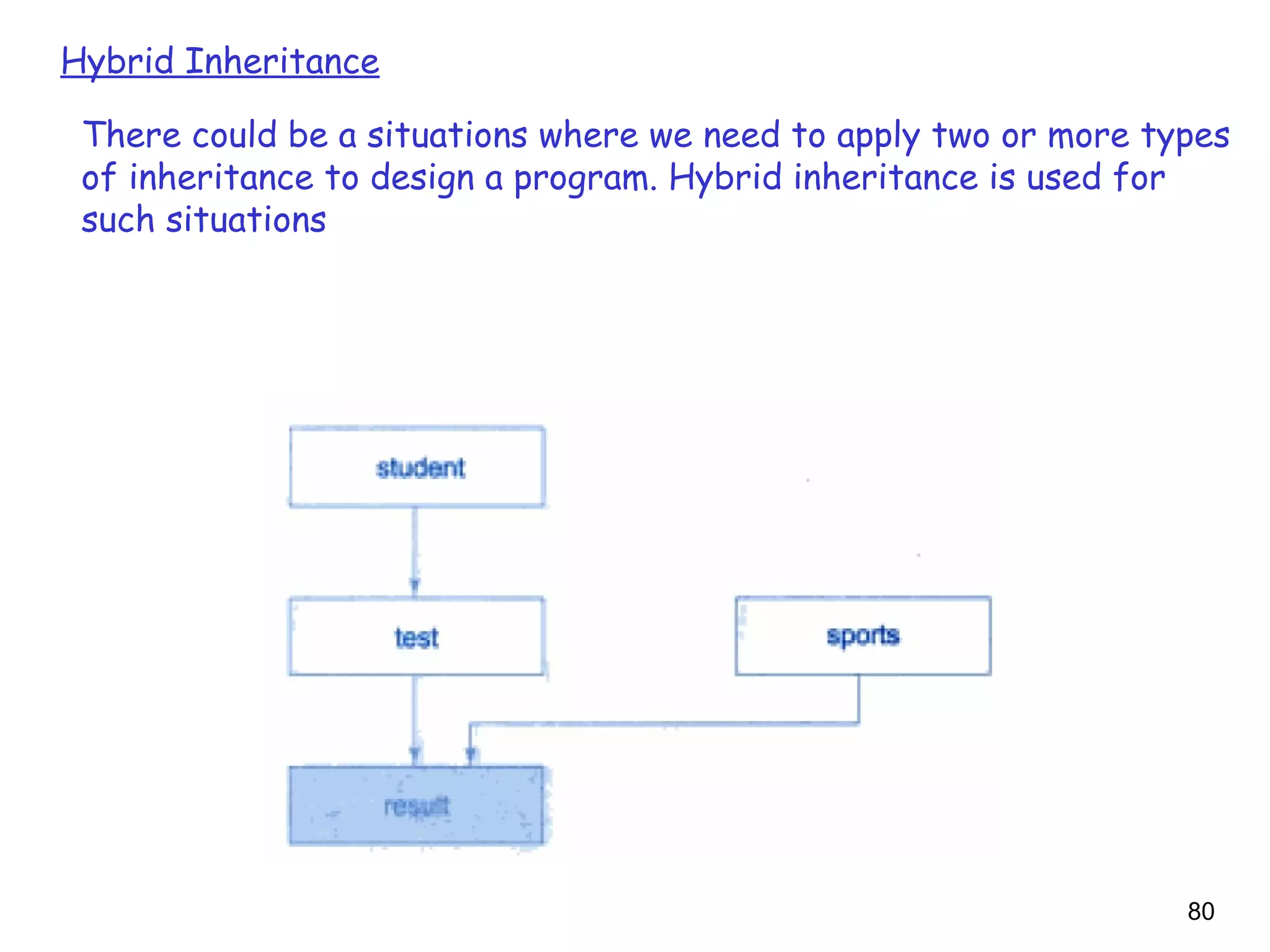

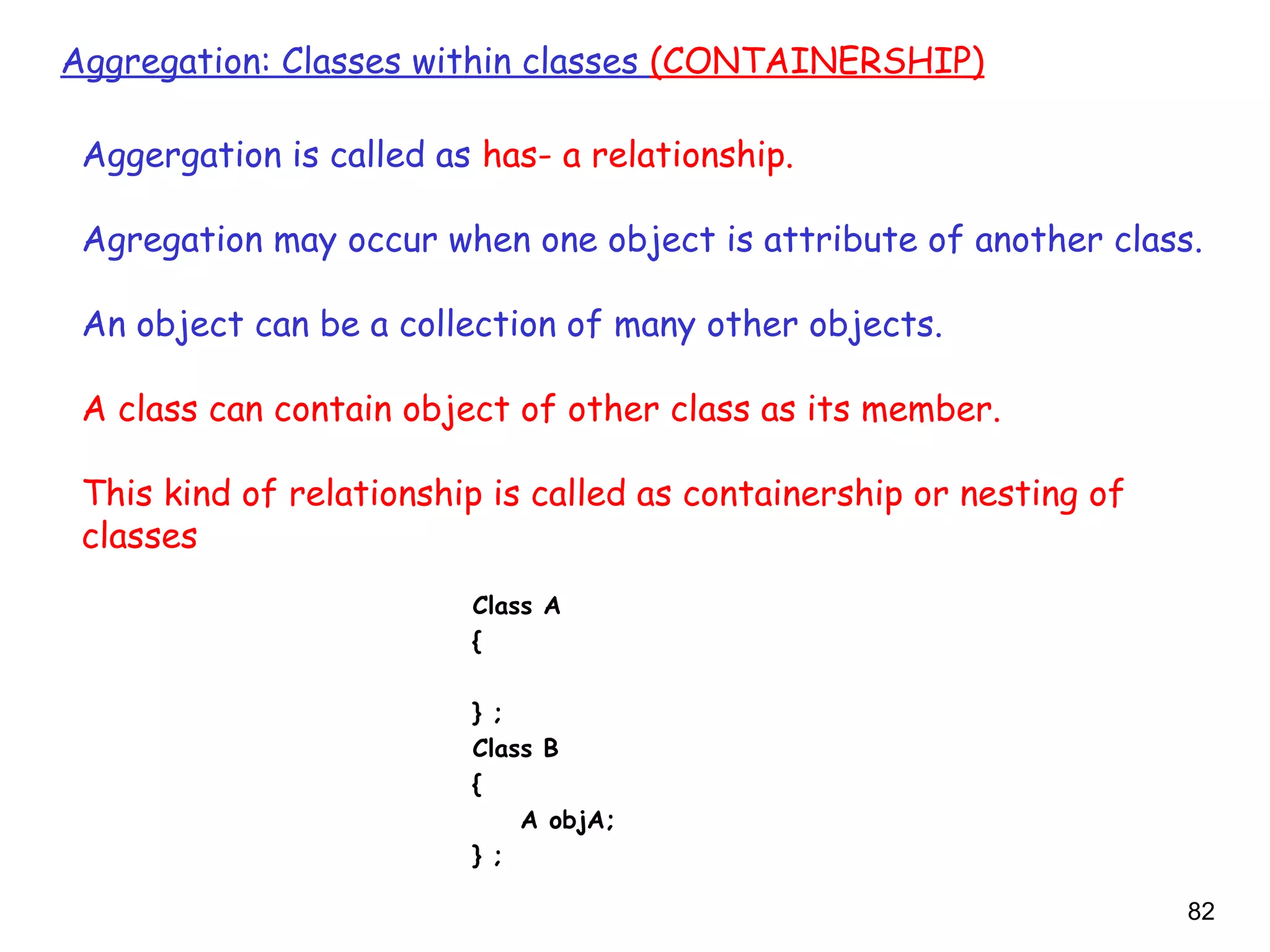
![Class Student
{
protected :
char name[20];
int rollno;
public :
void getdata( );
void putdata( );
} ;
void Student :: getdata( )
{
cout<<“Enter Roll No n”;
cin >> rollno;
cout<<“Enter Name n”;
cin >> name;
}
Void Student :: putdata( )
{
cout<<“Roll No=”<< rollno;
cout<<“Name=”<< name;
}
int main( )
{
result r;
r.display( );
return 0;
}
Class result
{
Student stud ;
public :
void display( );
} ;
Void result :: display( )
{
stud. getdata( );
stud. putdata( );
}
OUTPUT
Enter Roll No 111
Enter Name SACHIN
Roll No = 111
Name= SACHIN](https://image.slidesharecdn.com/oot-160725075650/75/Object-Oriented-Technologies-83-2048.jpg)
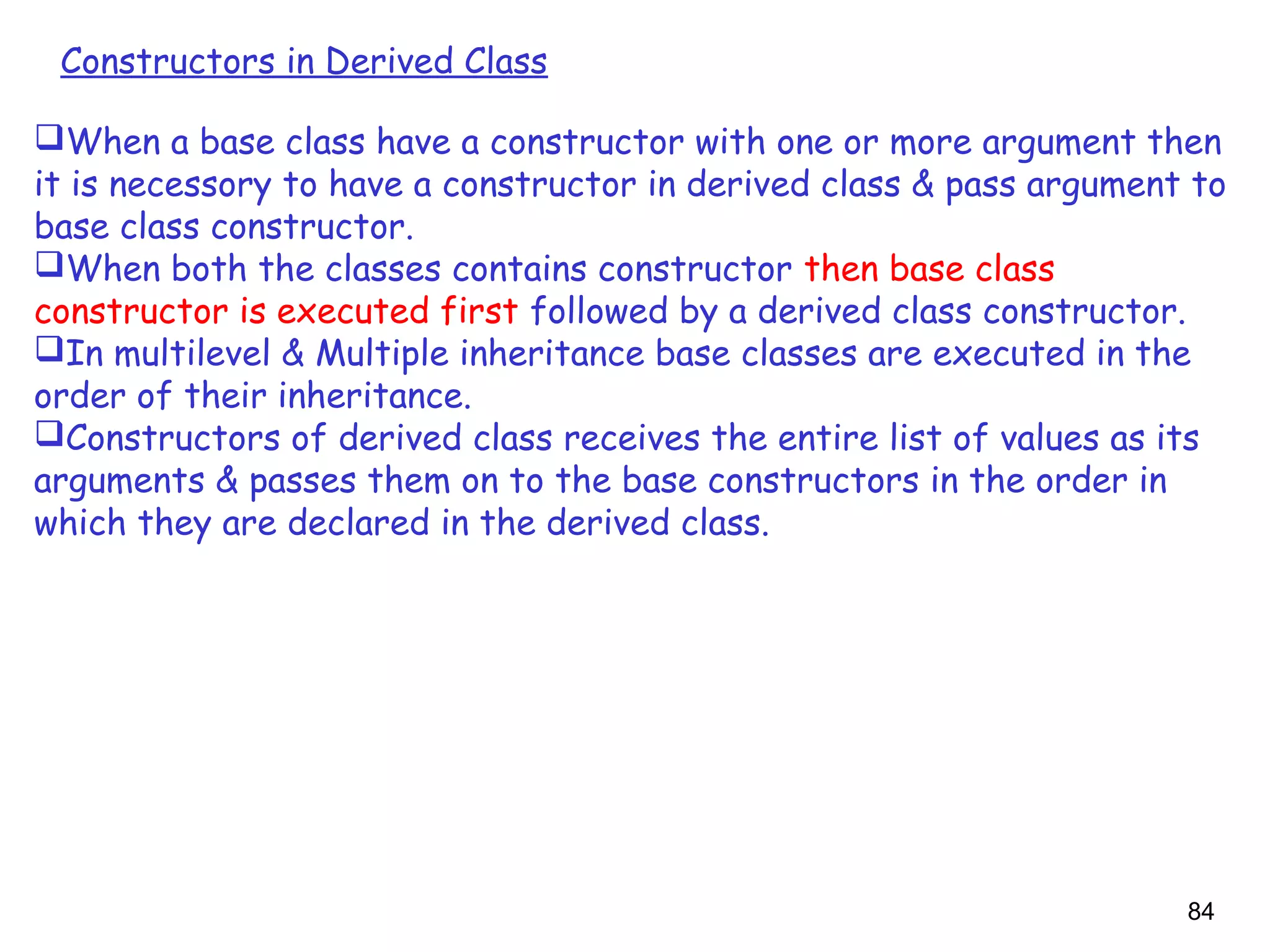
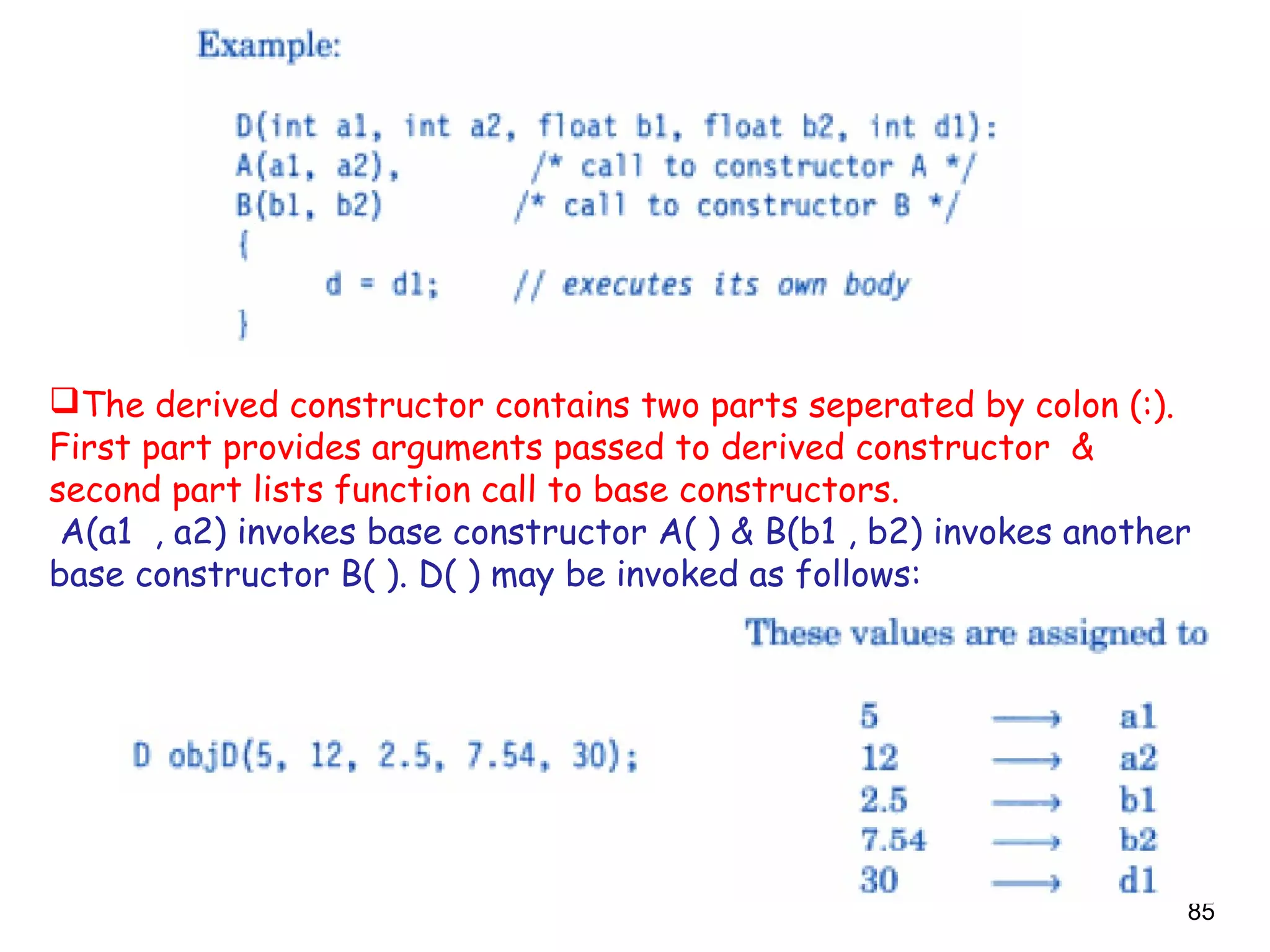

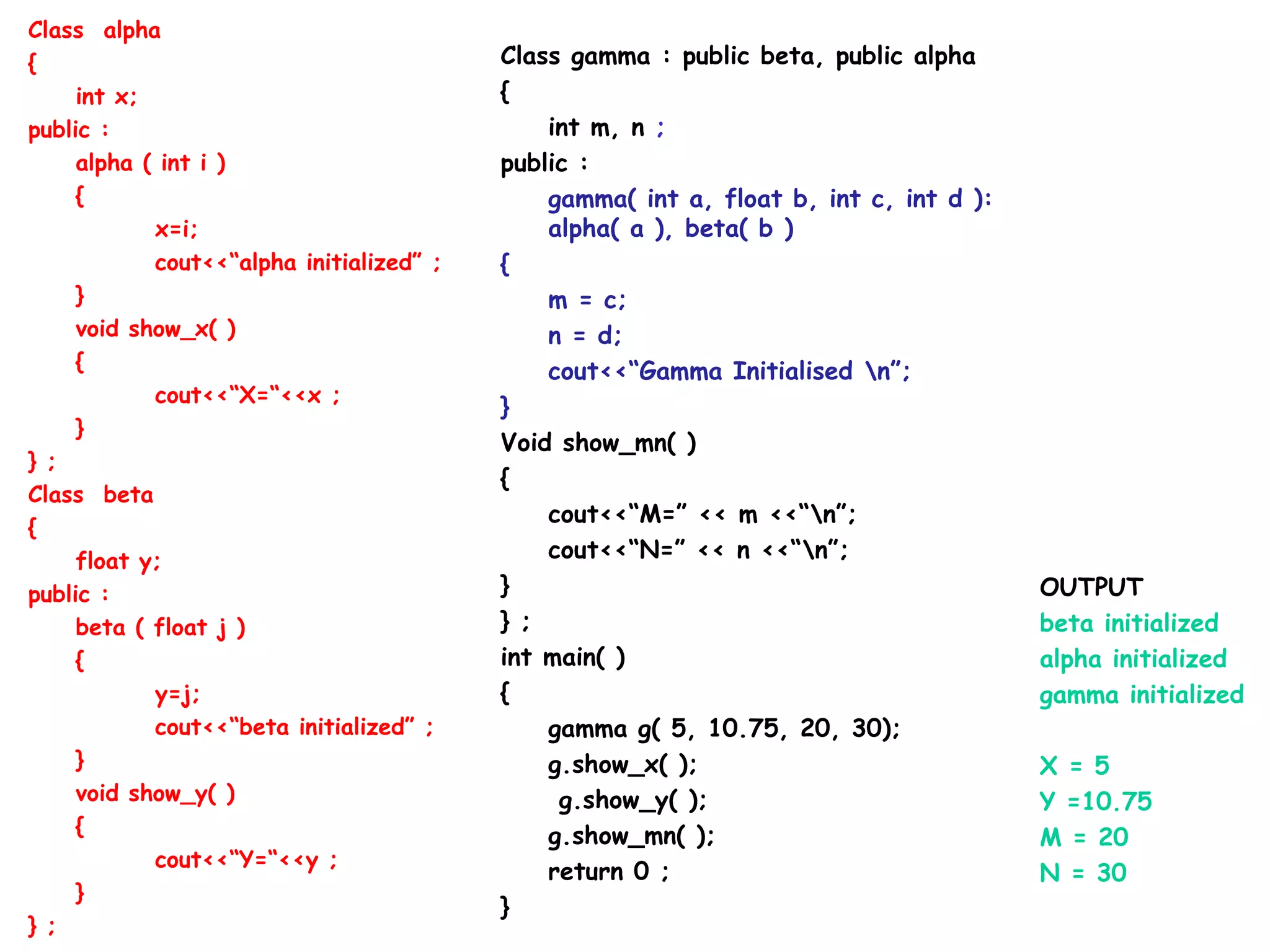

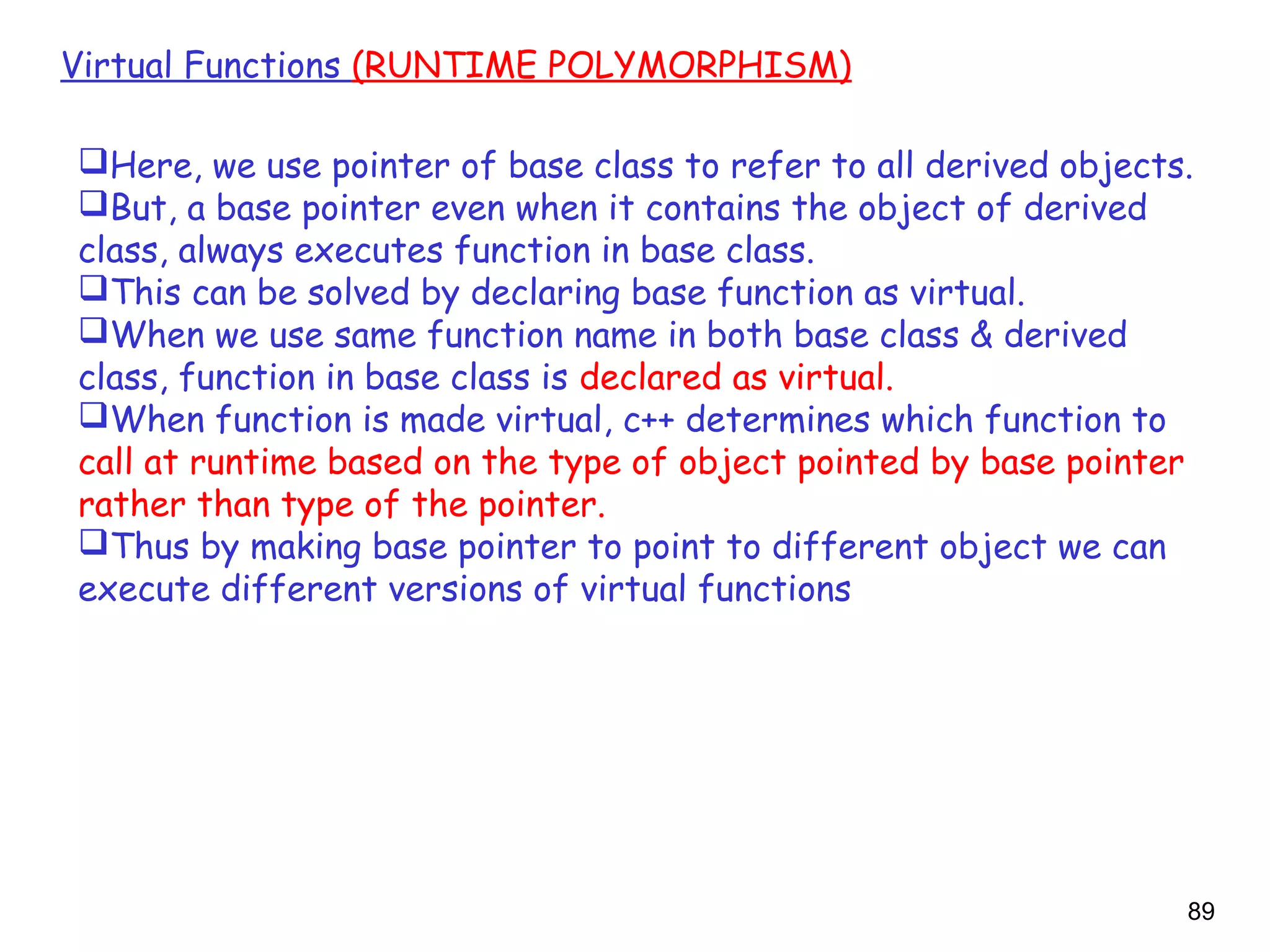
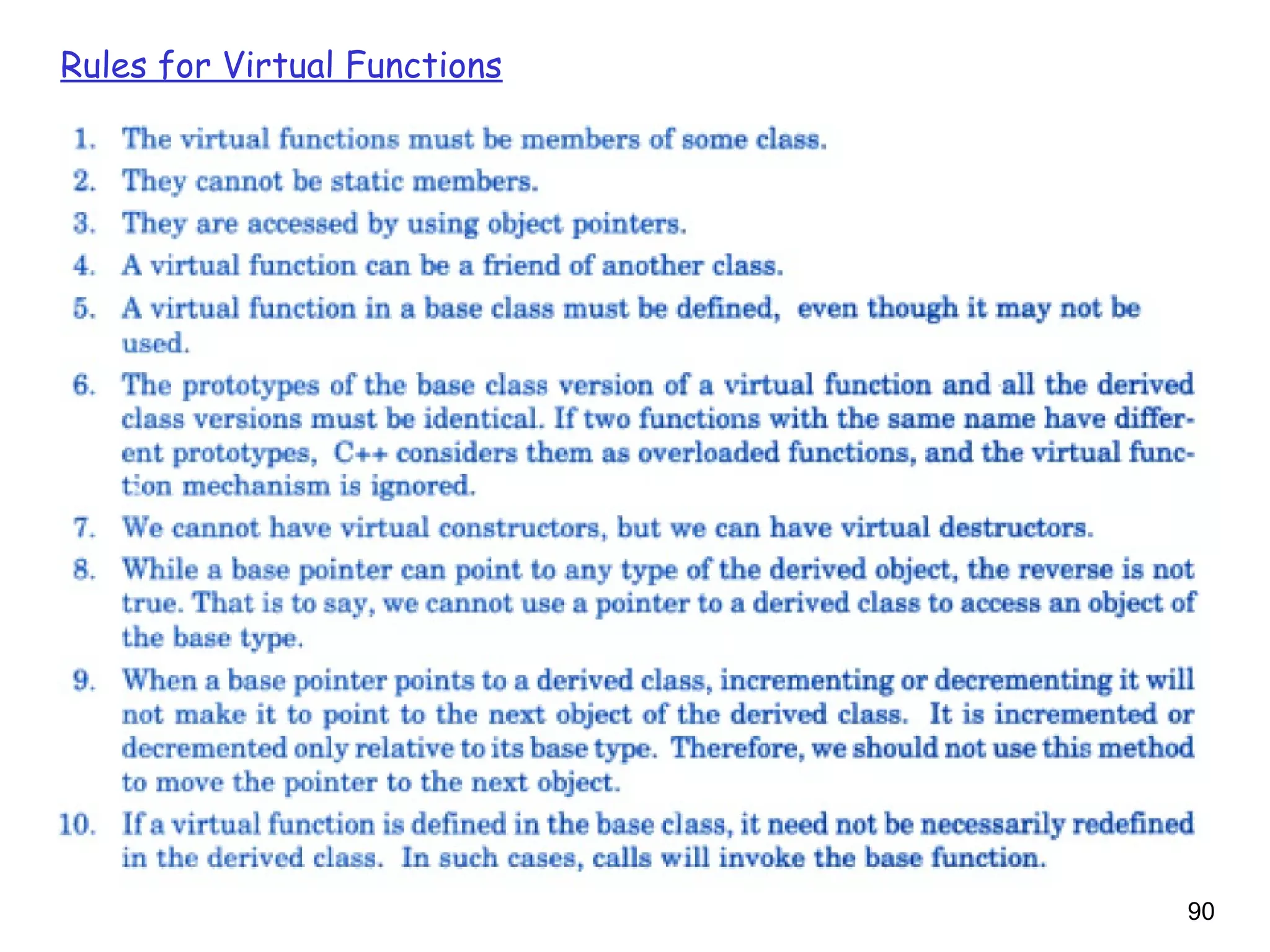




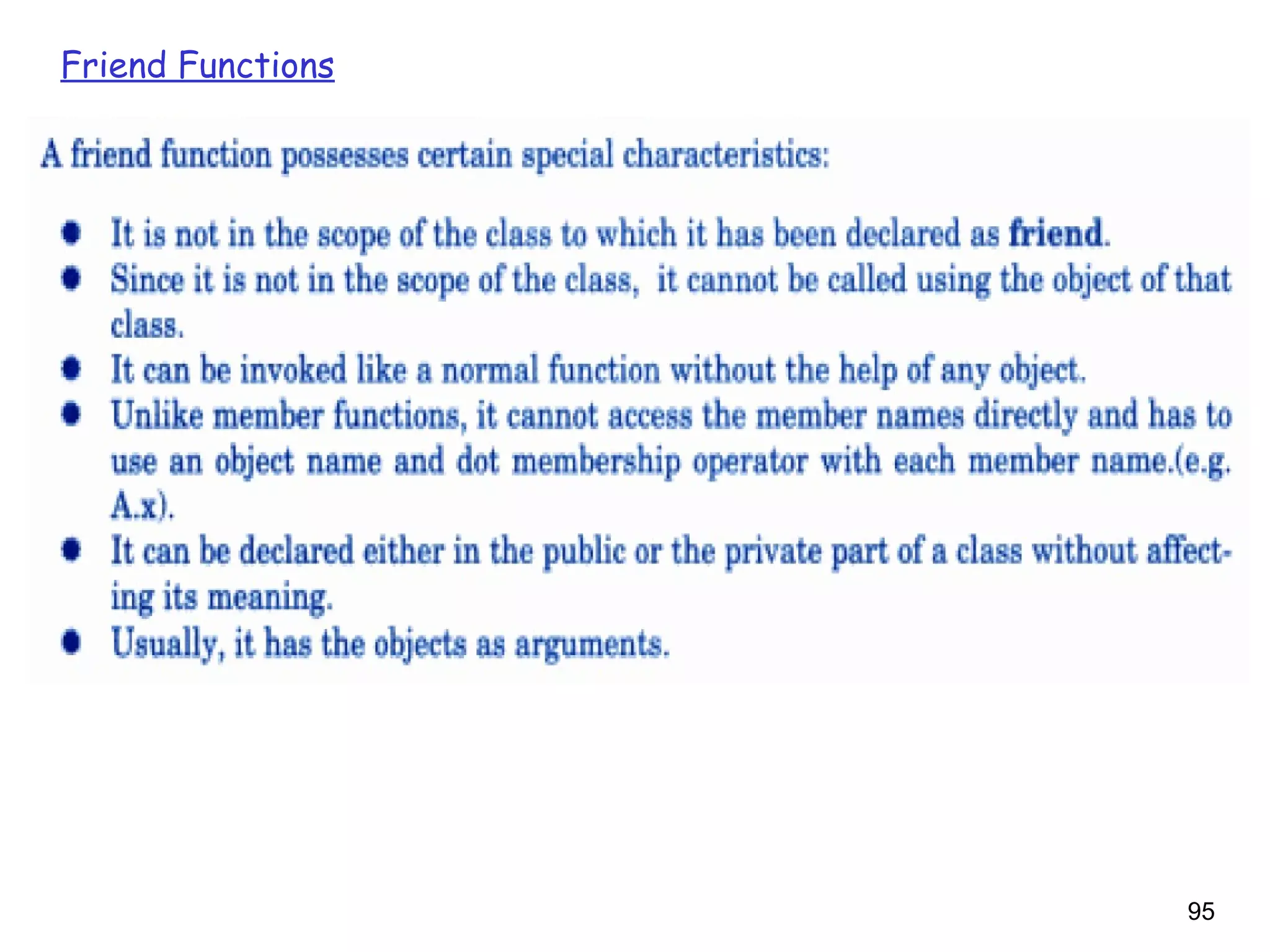
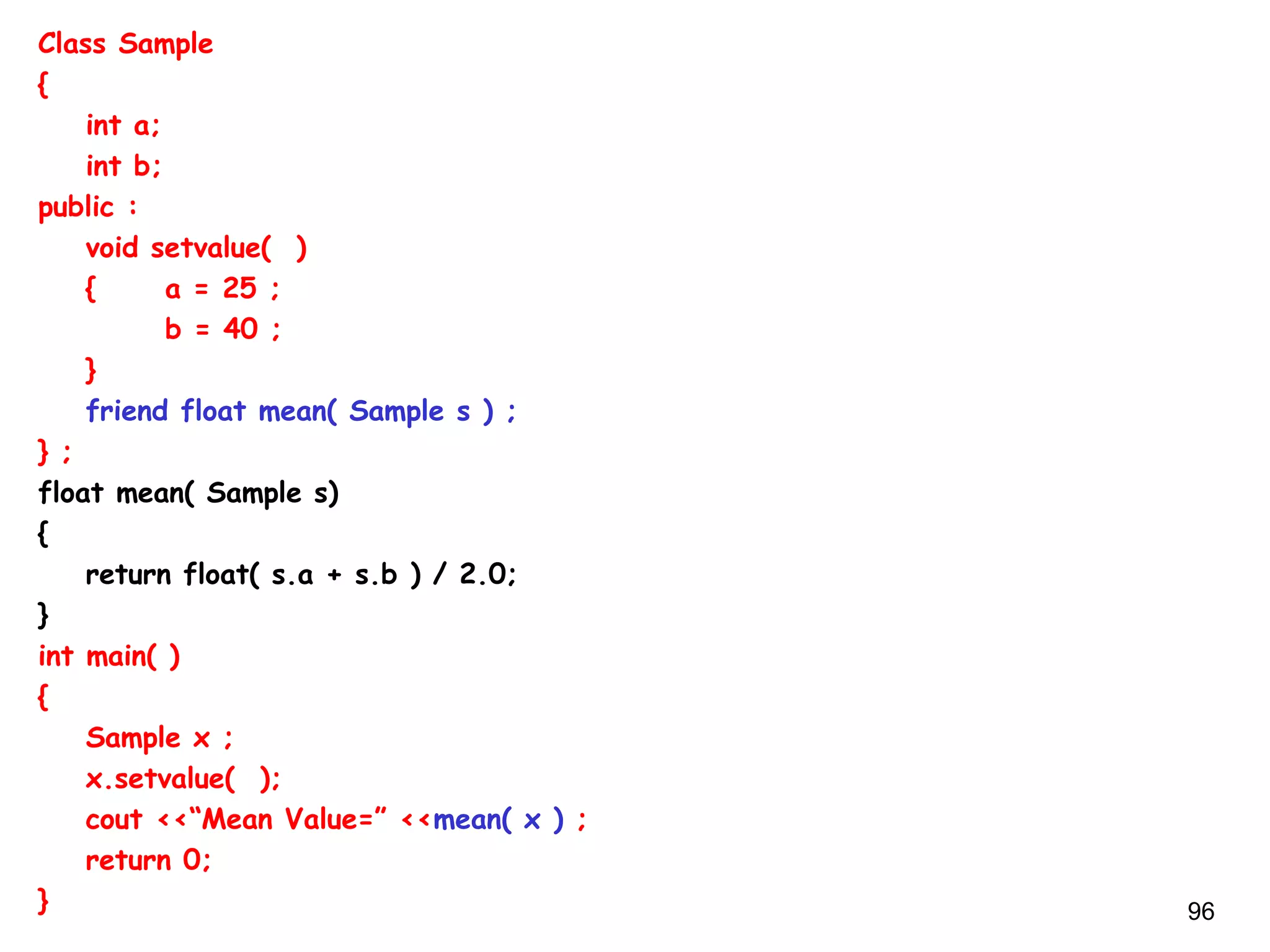


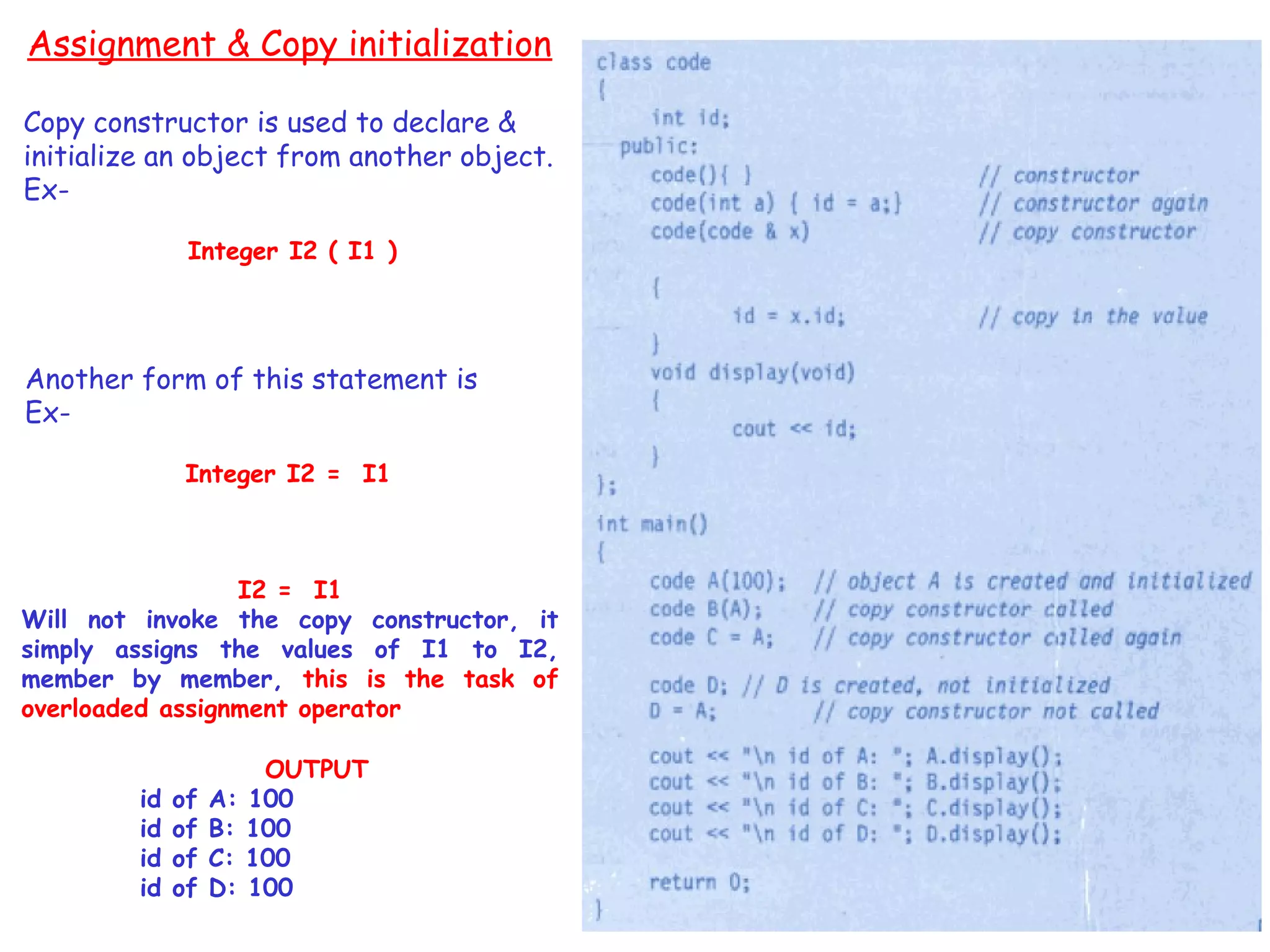
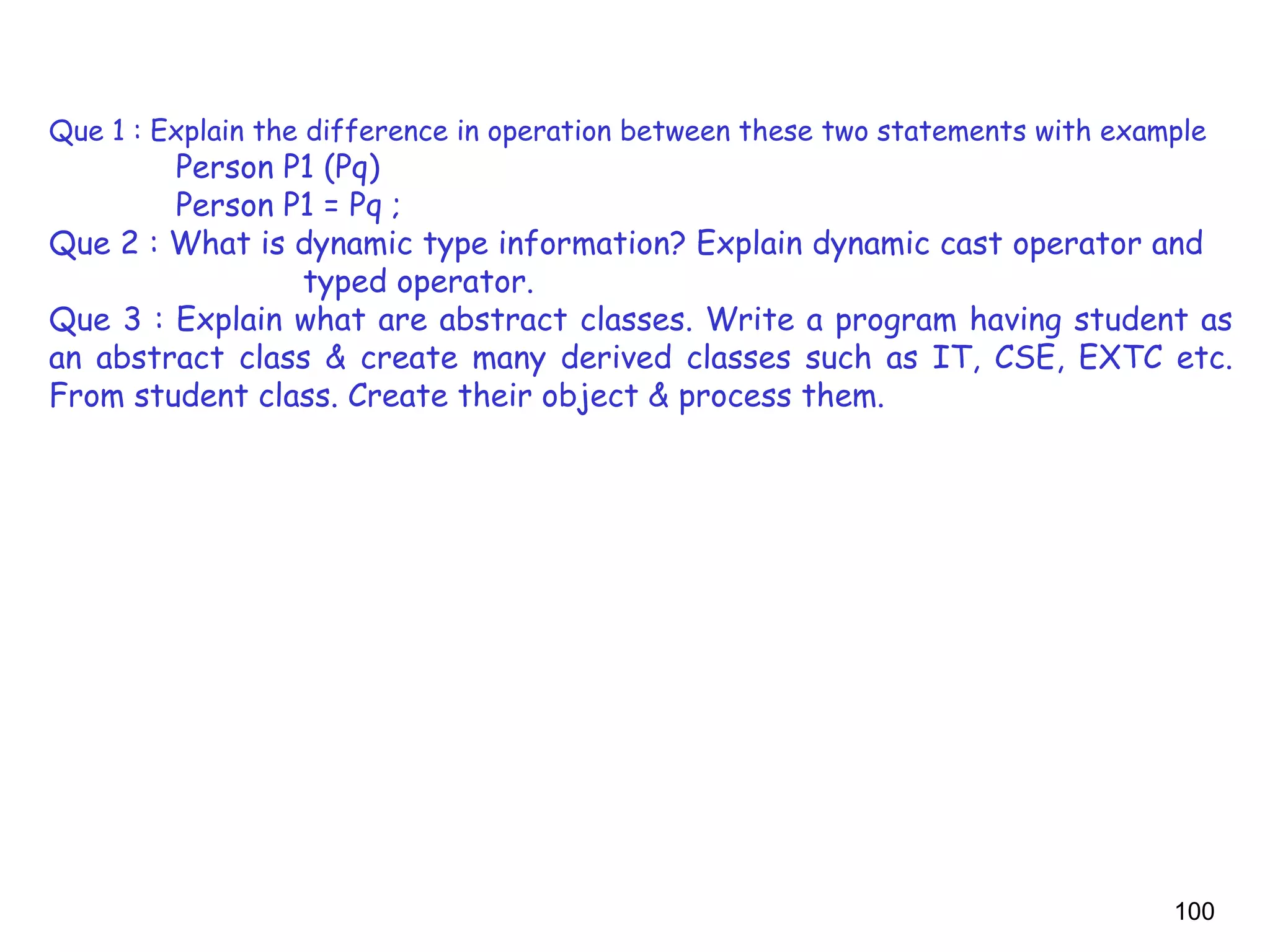
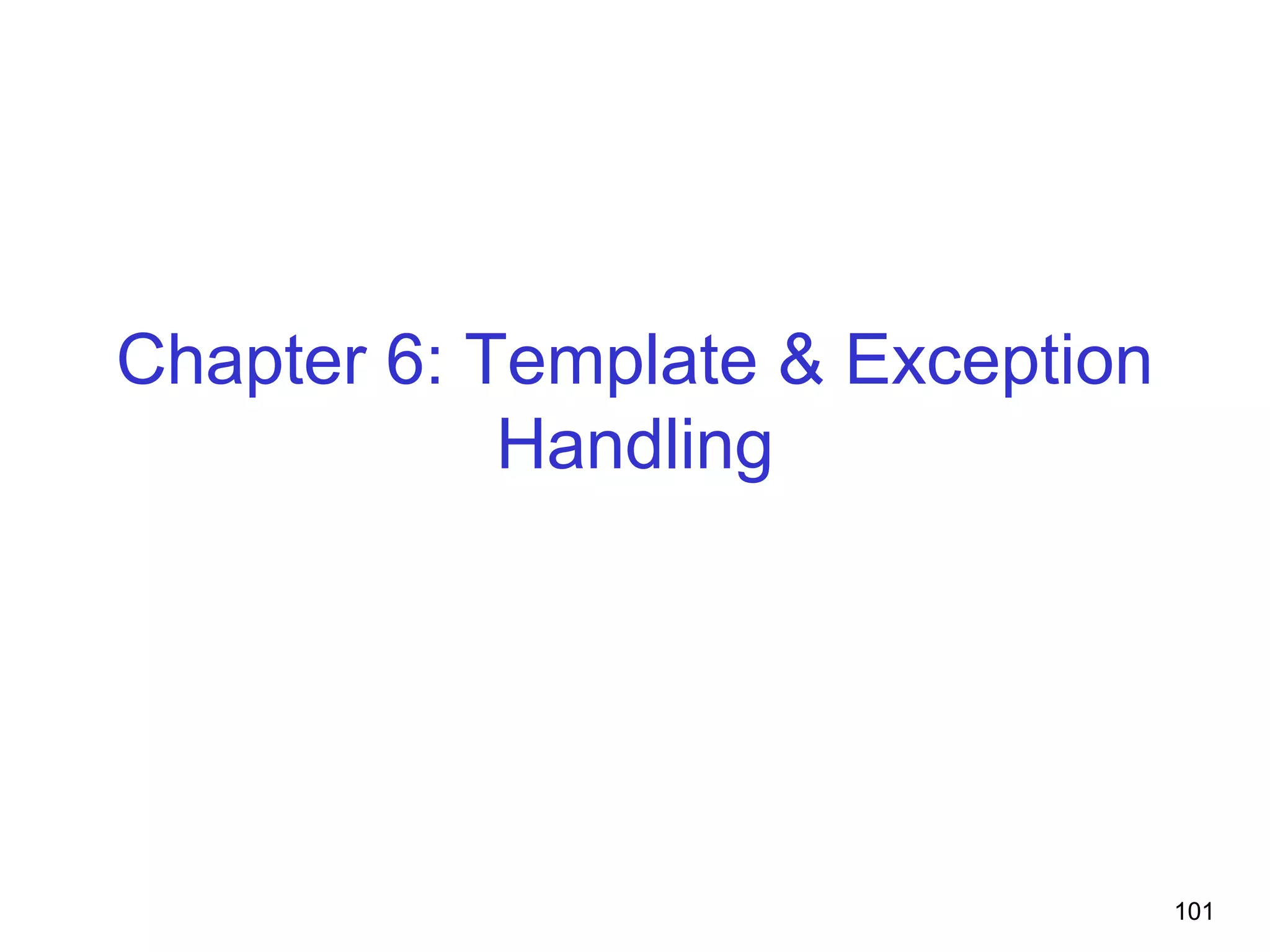

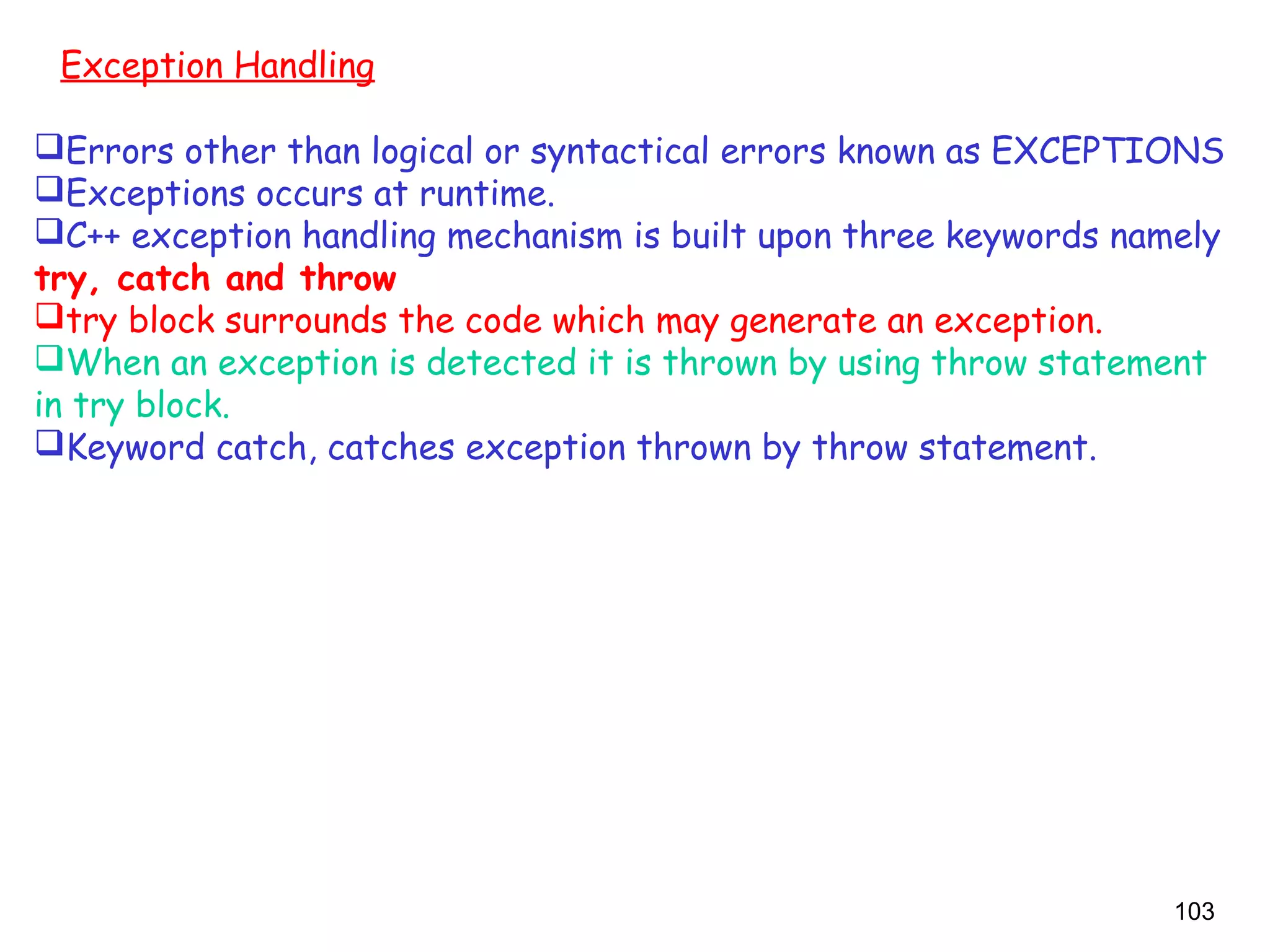







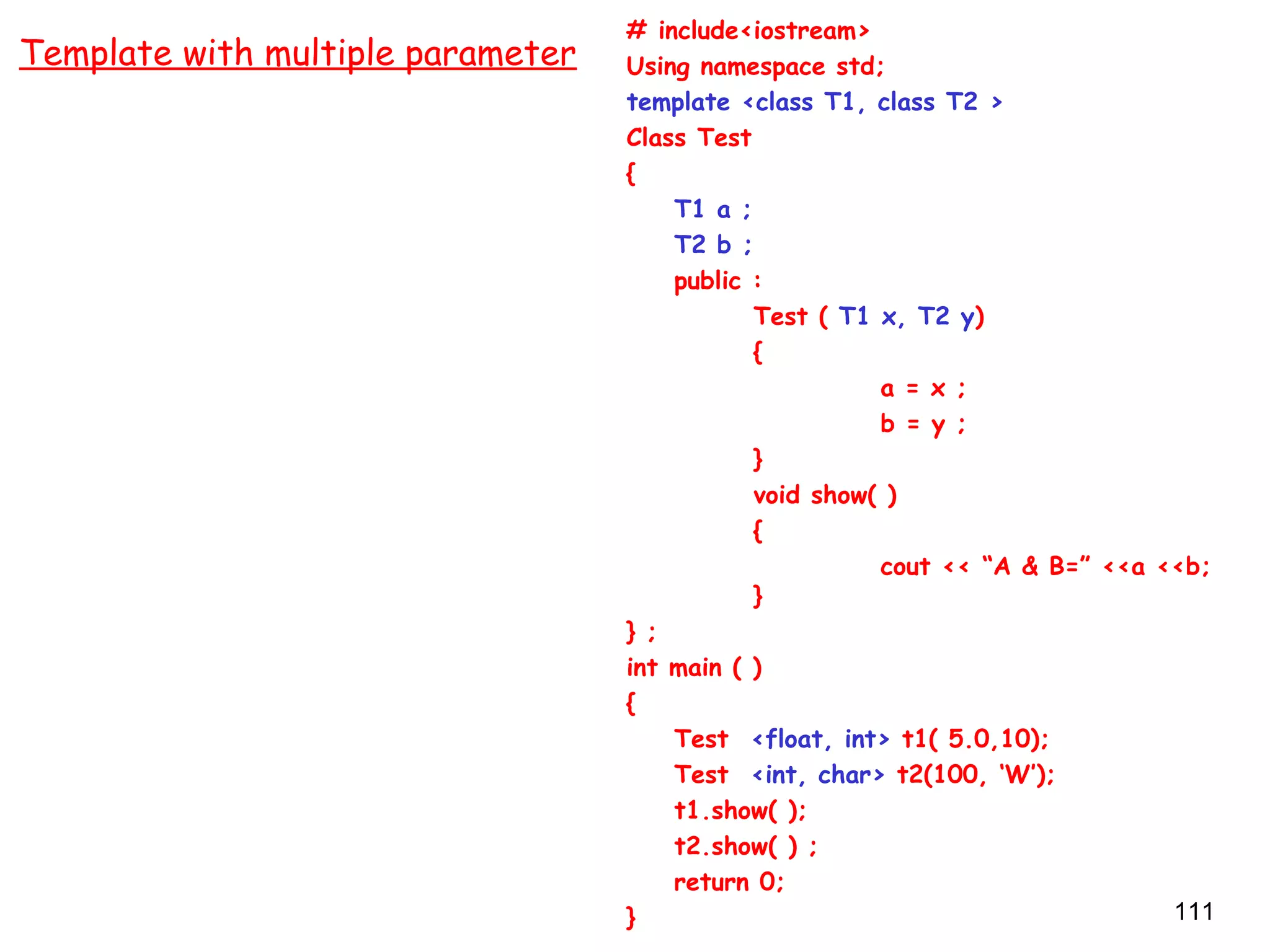
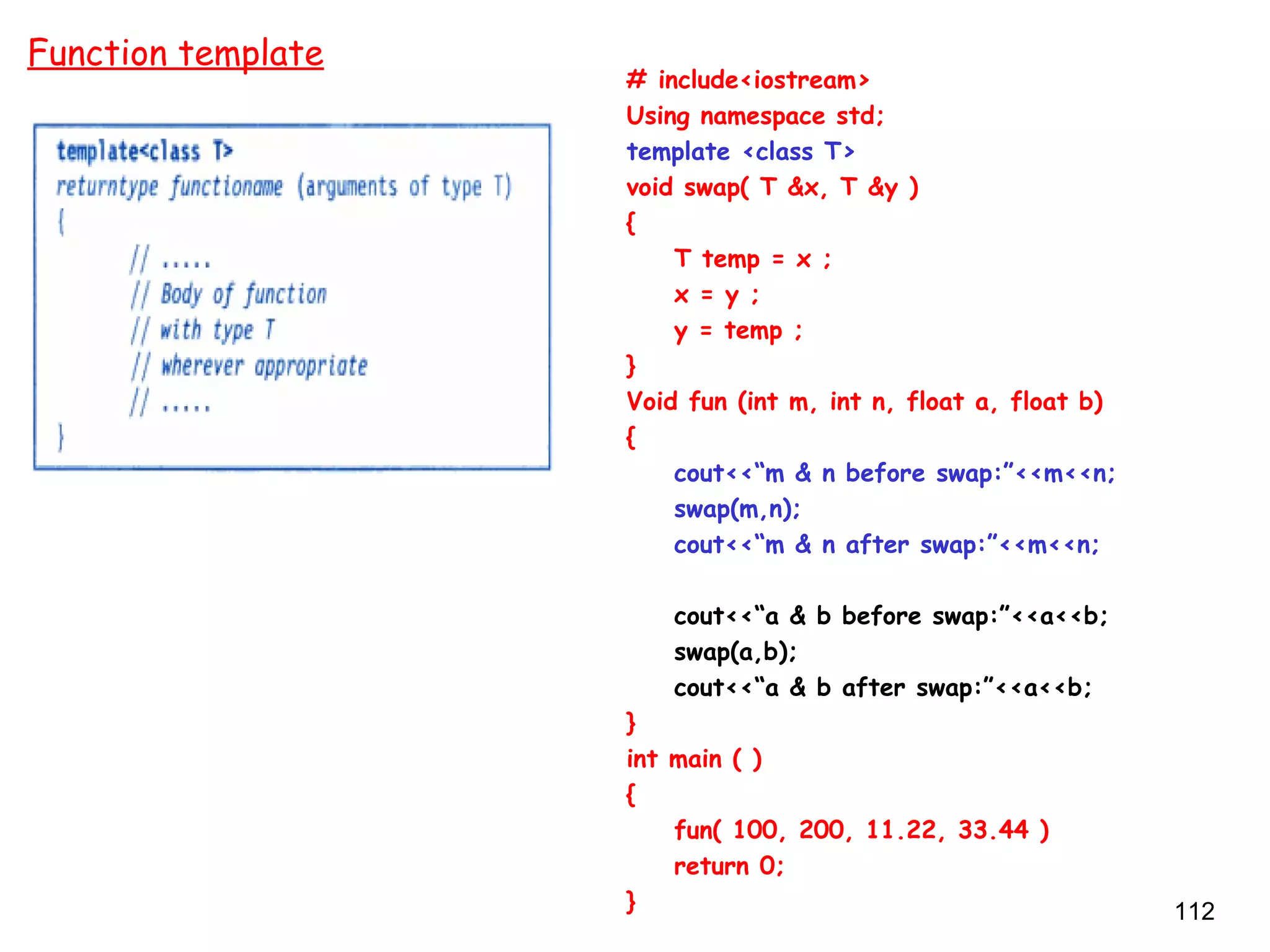
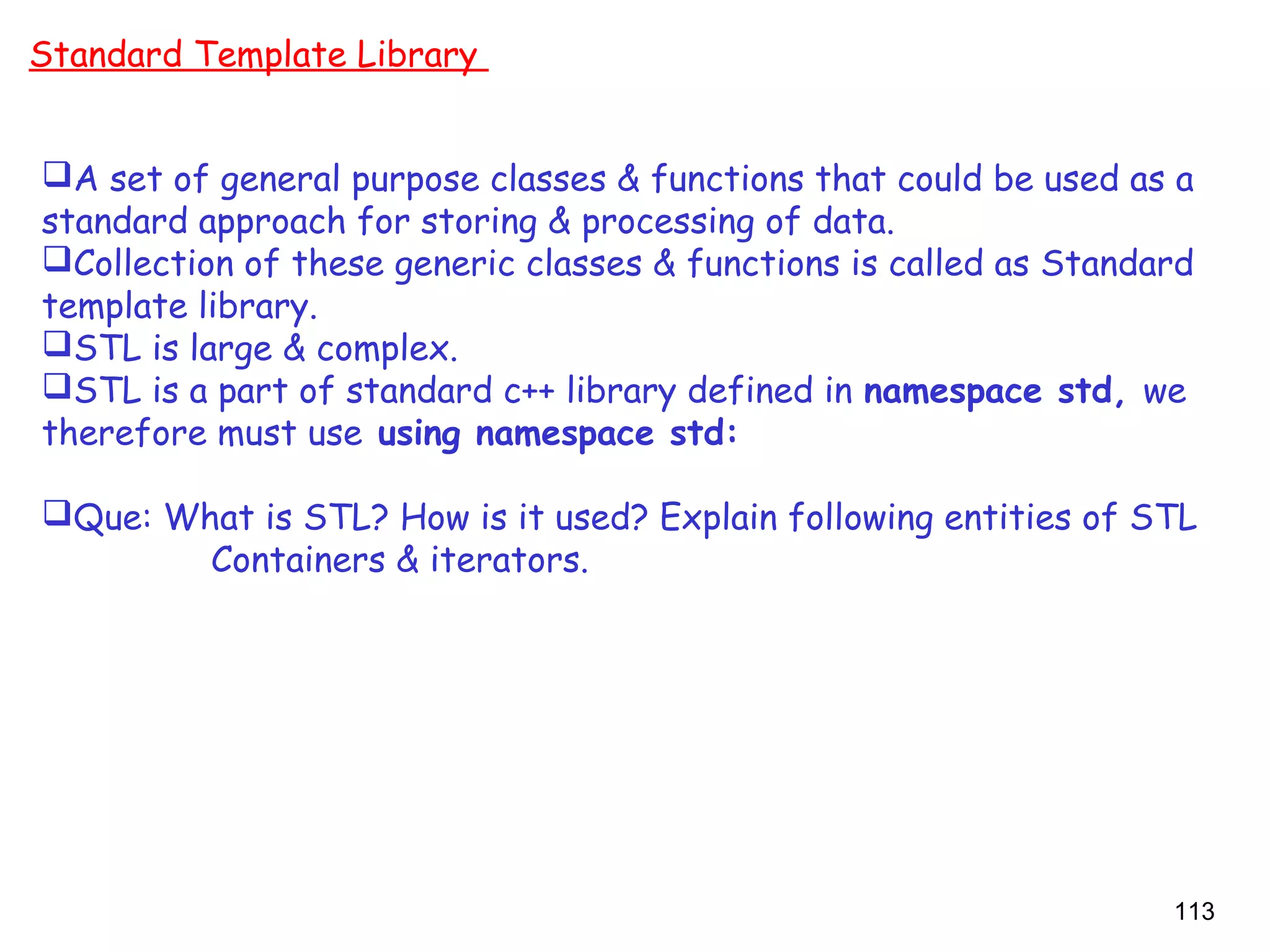







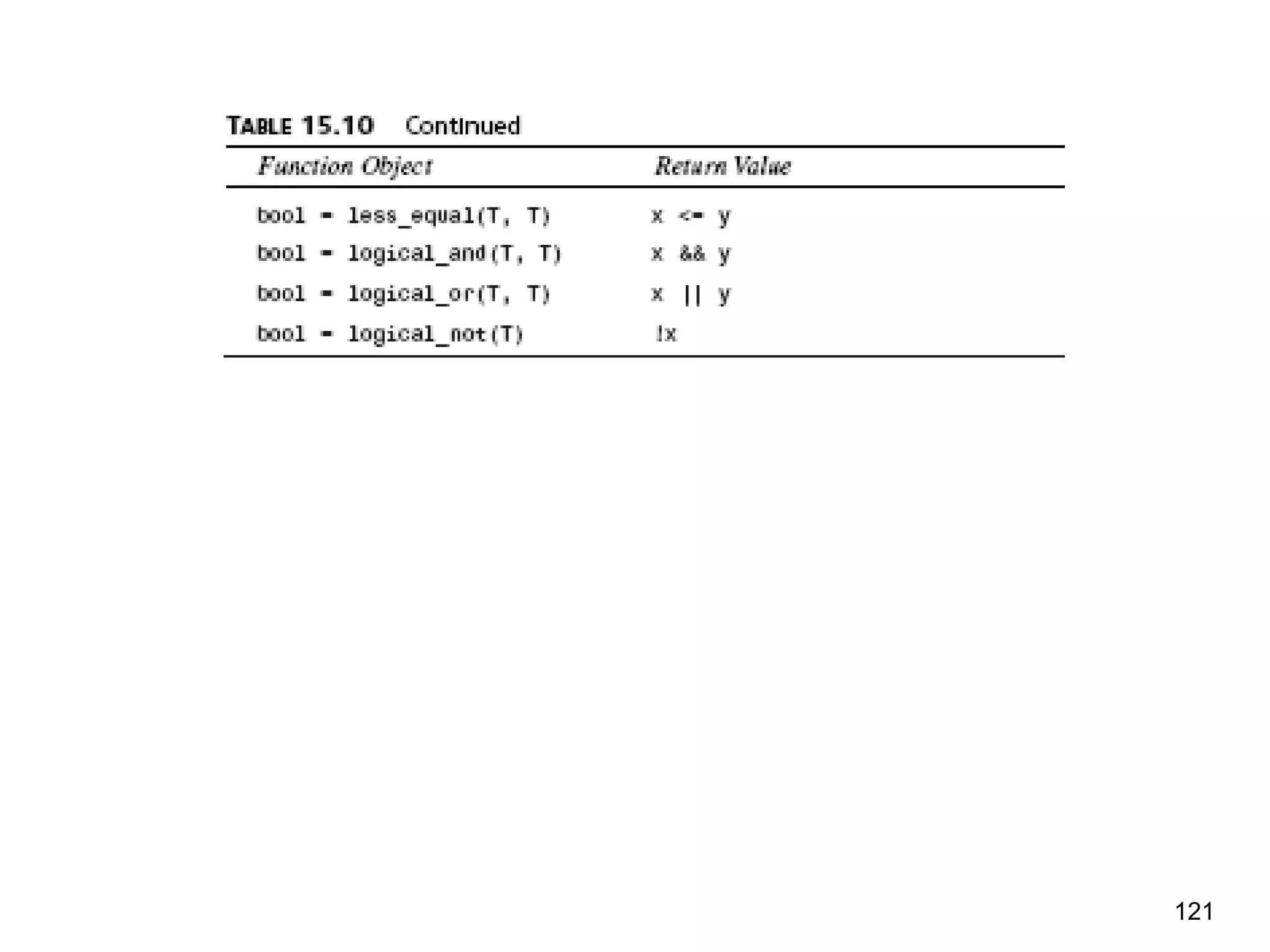

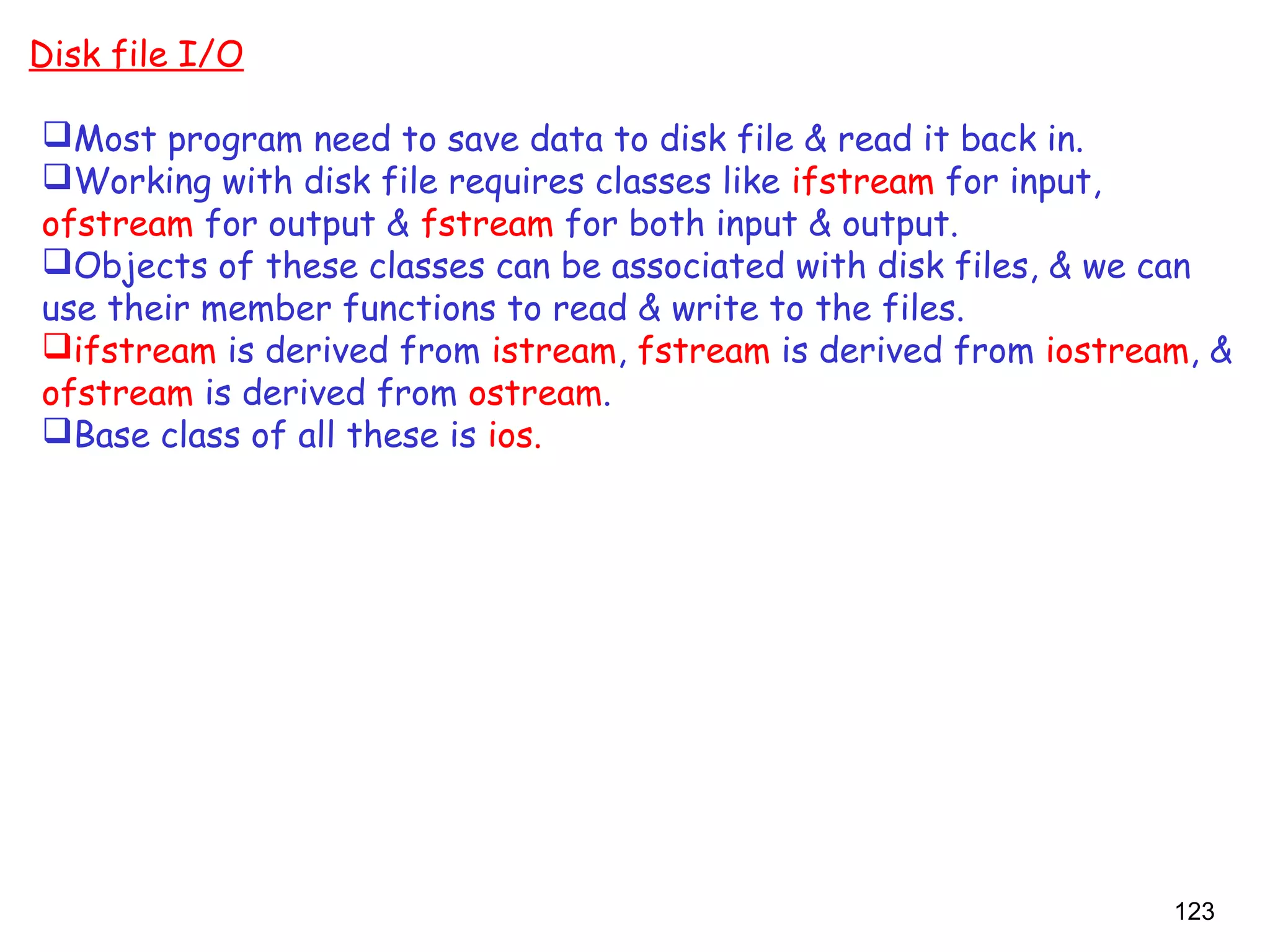

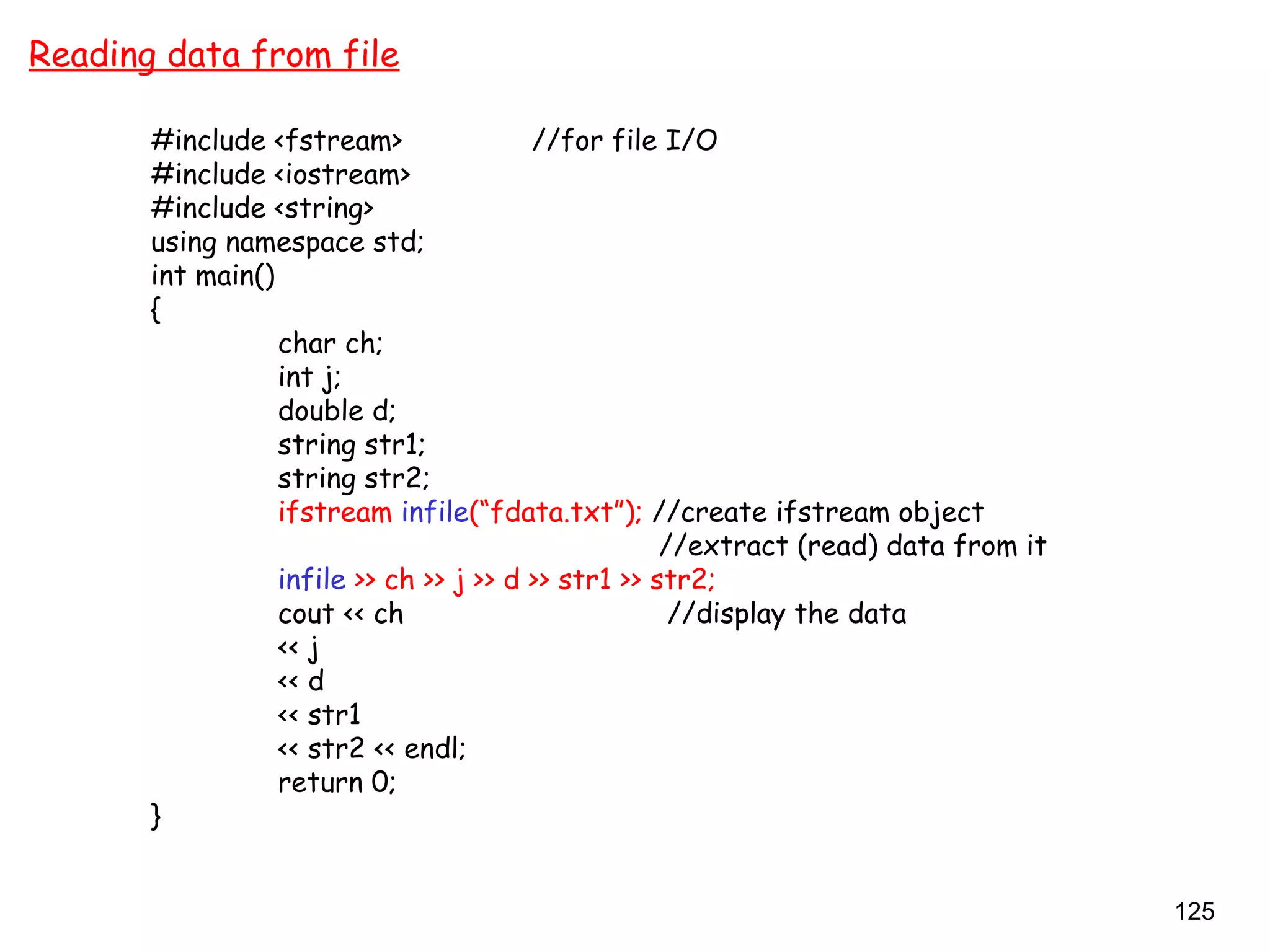
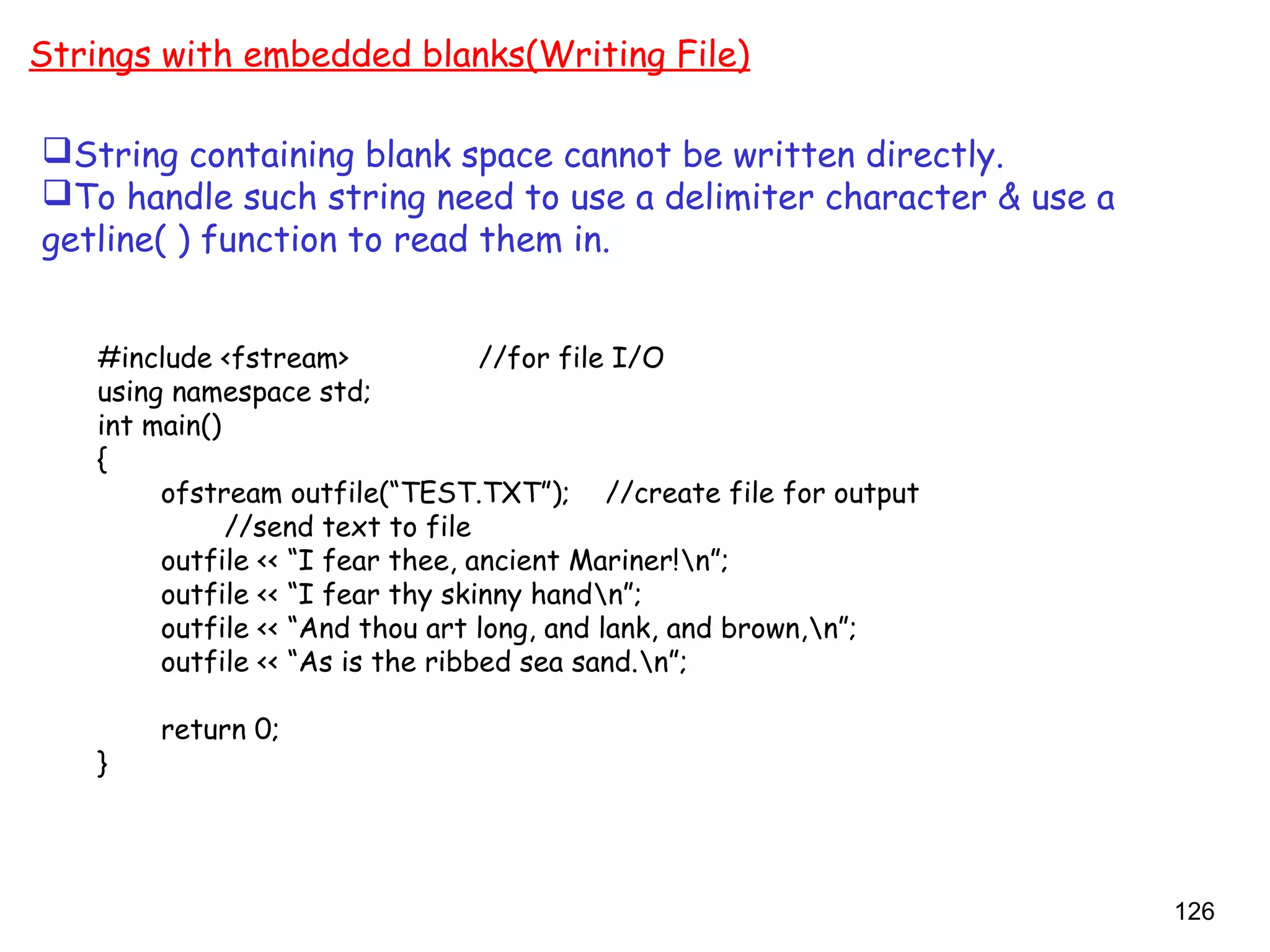
![127
Strings with embedded blanks(Reading File)
#include <fstream> //for file functions
#include <iostream>
using namespace std;
int main()
{
const int MAX = 80; //size of buffer
char buffer[MAX]; //character buffer
ifstream infile(“TEST.TXT”); //create file for input
while( ! infile.eof() ) //until end-of-file
{
infile.getline(buffer, MAX); //read a line of text
cout << buffer << endl; //display it
}
return 0;
}](https://image.slidesharecdn.com/oot-160725075650/75/Object-Oriented-Technologies-127-2048.jpg)
![128
Character I/O with put( ) & get( )
// Writing data to file
#include <fstream> //for file functions
#include <iostream>
#include <string>
using namespace std;
int main()
{
string str = “Time is a great teacher “ ;
ofstream outfile(“TEST.TXT”);
for(int j=0; j<str.size(); j++)
{
outfile.put( str[j] );
cout << “File writtenn”;
}
return 0;
}
// Reading data from file
#include <fstream>
#include <iostream>
#include <string>
using namespace std;
int main()
{
char ch;
ifstream infile(“TEST.TXT”);
while( infile )
{
infile.get(ch);
cout << ch;
}
cout << endl;
return 0;
}](https://image.slidesharecdn.com/oot-160725075650/75/Object-Oriented-Technologies-128-2048.jpg)
![129
Binary I/O #include <fstream>
#include <iostream>
using namespace std;
const int MAX = 100; //size of buffer
int buff[MAX]; //buffer for integers
int main()
{
for(int j=0; j<MAX; j++)
buff[j] = j;
// Writing to file
ofstream os(“edata.dat”, ios::binary);
os.write( reinterpret_cast <char*> (buff), MAX*sizeof(int) );
os.close();
for(j=0; j<MAX; j++)
buff[j] = 0;
// Reading from file
ifstream is(“edata.dat”, ios::binary);
is.read( reinterpret_cast<char*>(buff), MAX*sizeof(int) );
for(j=0; j<MAX; j++) //check data
if( buff[j] != j )
{
cout << “Data is incorrectn”;
return 1;
}
cout << “Data is correctn”;
return 0;
}](https://image.slidesharecdn.com/oot-160725075650/75/Object-Oriented-Technologies-129-2048.jpg)
![130
Writing an Object to disk
#include <fstream>
#include <iostream>
using namespace std;
class person
{
protected:
char name[80];
short age;
public:
void getData()
{
cout << “Enter name: “; cin >> name;
cout << “Enter age: “; cin >> age;
}
};
int main()
{
person pers;
pers.getData();
ofstream outfile(“PERSON.DAT”, ios::binary);
outfile.write(reinterpret_cast<char*>(&pers), sizeof(pers));
return 0;
}](https://image.slidesharecdn.com/oot-160725075650/75/Object-Oriented-Technologies-130-2048.jpg)
![131
Reading an Object From disk
#include <fstream>
#include <iostream>
using namespace std;
class person
{
protected:
char name[80];
short age;
public:
void showData()
{
cout << “Name: “ << name << endl;
cout << “Age: “ << age << endl;
}
};
int main( )
{
person pers;
ifstream infile(“PERSON.DAT”, ios::binary);
infile.read( reinterpret_cast<char*>(&pers), sizeof(pers) );
pers.showData();
return 0;
}](https://image.slidesharecdn.com/oot-160725075650/75/Object-Oriented-Technologies-131-2048.jpg)
![132
I/O with multiple objects
#include <fstream>
#include <iostream>
using namespace std;
class person
{
protected:
char name[80];
int age;
public:
void getData()
{
cout << “n Enter name: “;
cin >> name;
cout << “ Enter age: “;
cin >> age;
}
void showData()
{
cout << “n Name: “ <<
name;
cout << “n Age: “ << age;
}
};
int main()
{
char ch;
person pers;
fstream file;
file.open(“GROUP.DAT”, ios::app | ios::out |ios::in |
ios::binary );
do {
cout << “nEnter person’s data:”;
pers.getData();
file.write( reinterpret_cast<char*>(&pers),
sizeof(pers) );
cout << “Enter another person (y/n)? “;
cin >> ch;
}
while(ch==’y’);
file.seekg(0);
file.read( reinterpret_cast<char*>(&pers), sizeof(pers) );
while( !file.eof() )
{
cout << “nPerson:”; //display person
pers.showData(); //read another person
file.read( reinterpret_cast<char*>(&pers),
sizeof(pers) );
}
cout << endl;
return 0;
}](https://image.slidesharecdn.com/oot-160725075650/75/Object-Oriented-Technologies-132-2048.jpg)


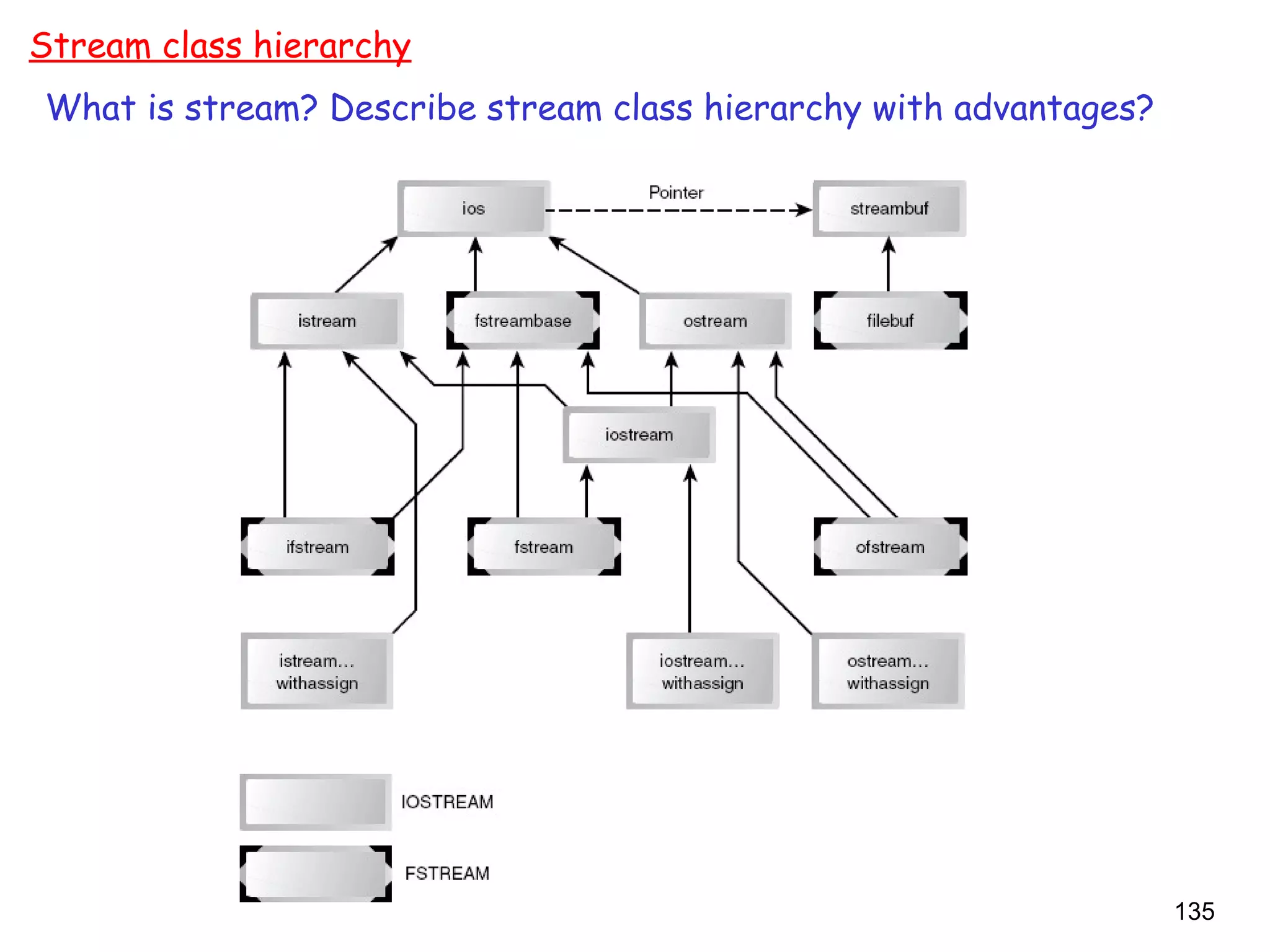

![137
Memory as stream object
#include <strstream>
#include <iostream>
#include <iomanip>
using namespace std;
const int SIZE = 80;
int main()
{
char ch = ‘x’;
int j = 77;
double d = 67890.12345;
char str1[] = “New”;
char str2[] = “Delhi”;
char membuff[SIZE];
ostrstream os(membuff, SIZE);
os << “ch=” << ch << endl
<< “j=” << j << endl
<< setiosflags(ios::fixed)
<< setprecision(2)
<< “d=” << d << endl
<< “str1=” << str1 << endl
<< “str2=” << str2 << endl
<< ends;
cout << membuff;
return 0;
}
OUTPUT:
ch=xnj=77nd=67890.12nstr1=Newnstr2=Delhin0](https://image.slidesharecdn.com/oot-160725075650/75/Object-Oriented-Technologies-137-2048.jpg)

![139
Command line argument
#include <iostream>
using namespace std;
int main(int argc, char* argv[] )
{
cout << “nargc = “ << argc << endl;
for(int j=0; j<argc; j++)
cout << “Argument “ << j << “ = “ << argv[j] << endl;
return 0;
}
a sample interaction with the program:
C:C++BOOKChap12>comline uno dos tres
OUTPUT
argc = 4
Argument 0 = C:CPPCHAP12COMLINE.EXE
Argument 1 = uno
Argument 2 = dos
Argument 3 = tres](https://image.slidesharecdn.com/oot-160725075650/75/Object-Oriented-Technologies-139-2048.jpg)